Abstract
Male reproductive health has deteriorated in many countries during the last few decades. In the 1990s, declining semen quality has been reported from Belgium, Denmark, France, and Great Britain. The incidence of testicular cancer has increased during the same time incidences of hypospadias and cryptorchidism also appear to be increasing. Similar reproductive problems occur in many wildlife species. There are marked geographic differences in the prevalence of male reproductive disorders. While the reasons for these differences are currently unknown, both clinical and laboratory research suggest that the adverse changes may be inter-related and have a common origin in fetal life or childhood. Exposure of the male fetus to supranormal levels of estrogens, such as diethlylstilbestrol, can result in the above-mentioned reproductive defects. The growing number of reports demonstrating that common environmental contaminants and natural factors possess estrogenic activity presents the working hypothesis that the adverse trends in male reproductive health may be, at least in part, associated with exposure to estrogenic or other hormonally active (e.g., antiandrogenic) environmental chemicals during fetal and childhood development. An extensive research program is needed to understand the extent of the problem, its underlying etiology, and the development of a strategy for prevention and intervention.
Full text
PDF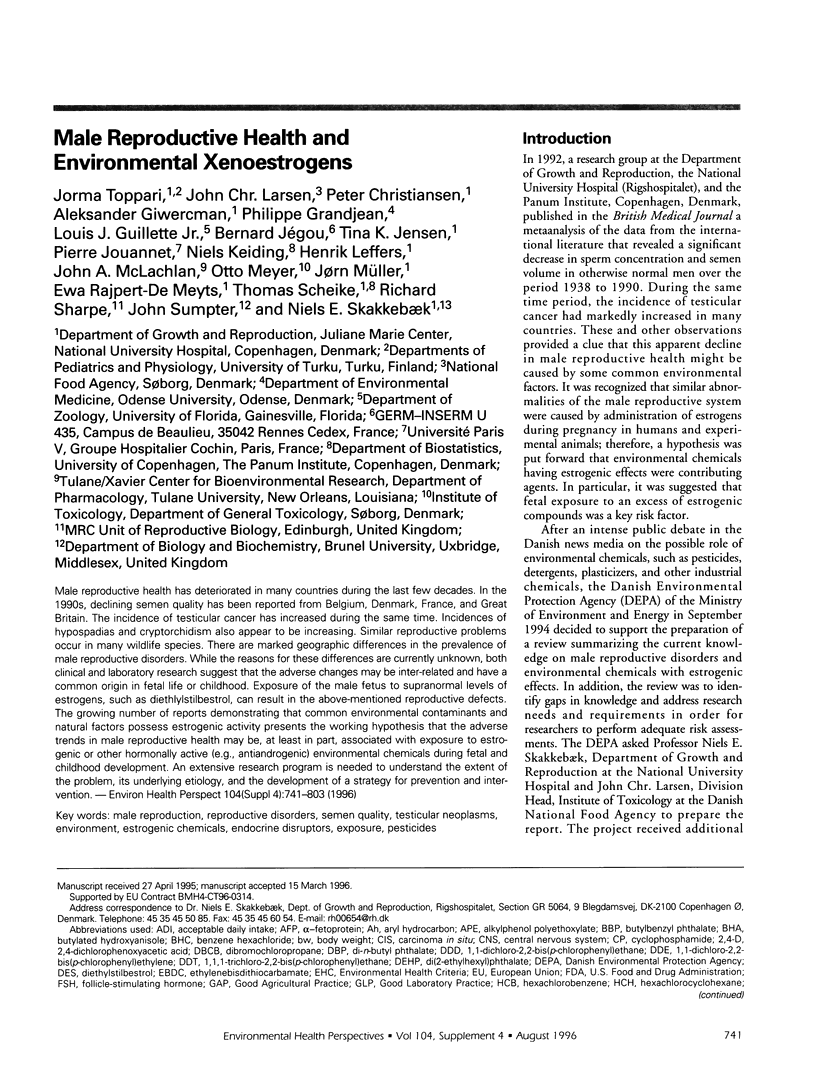
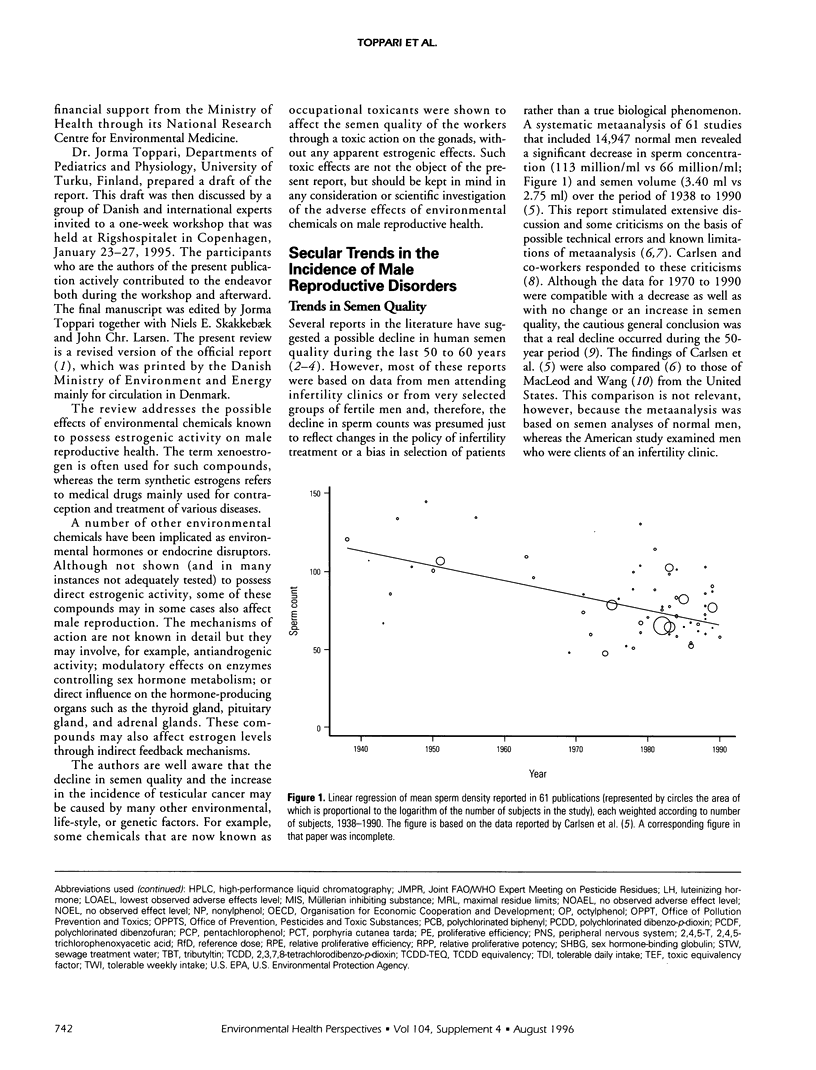


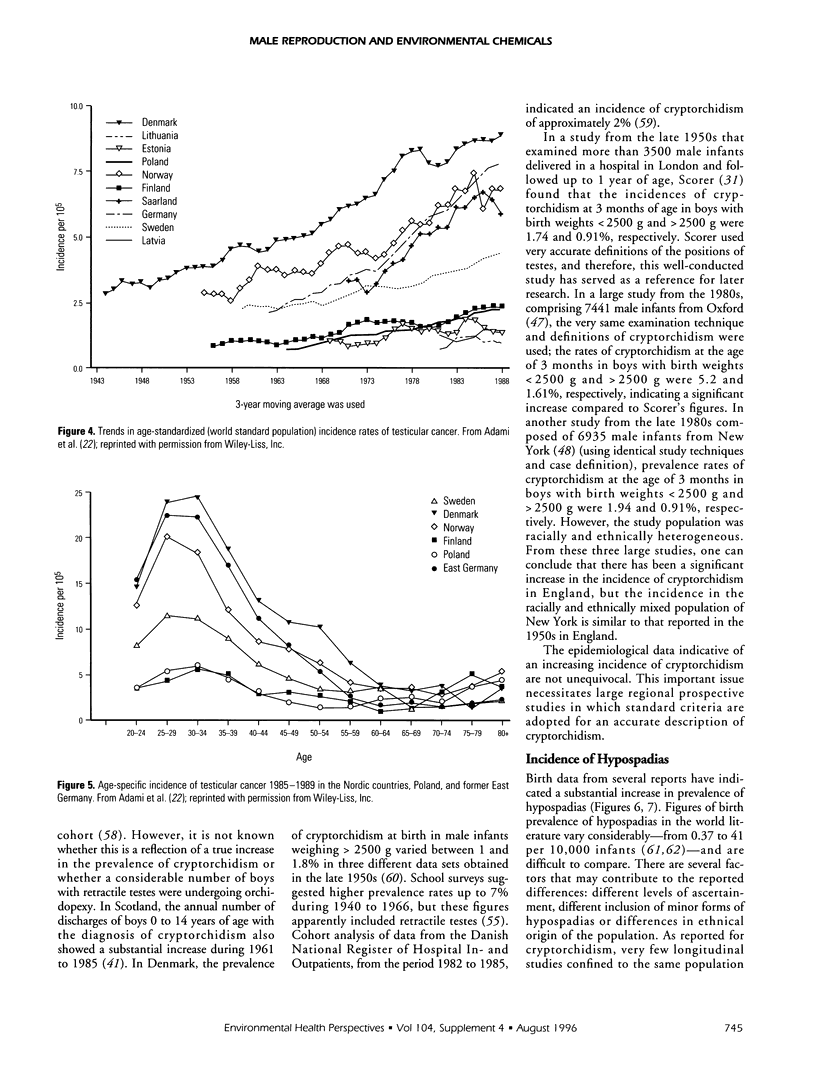





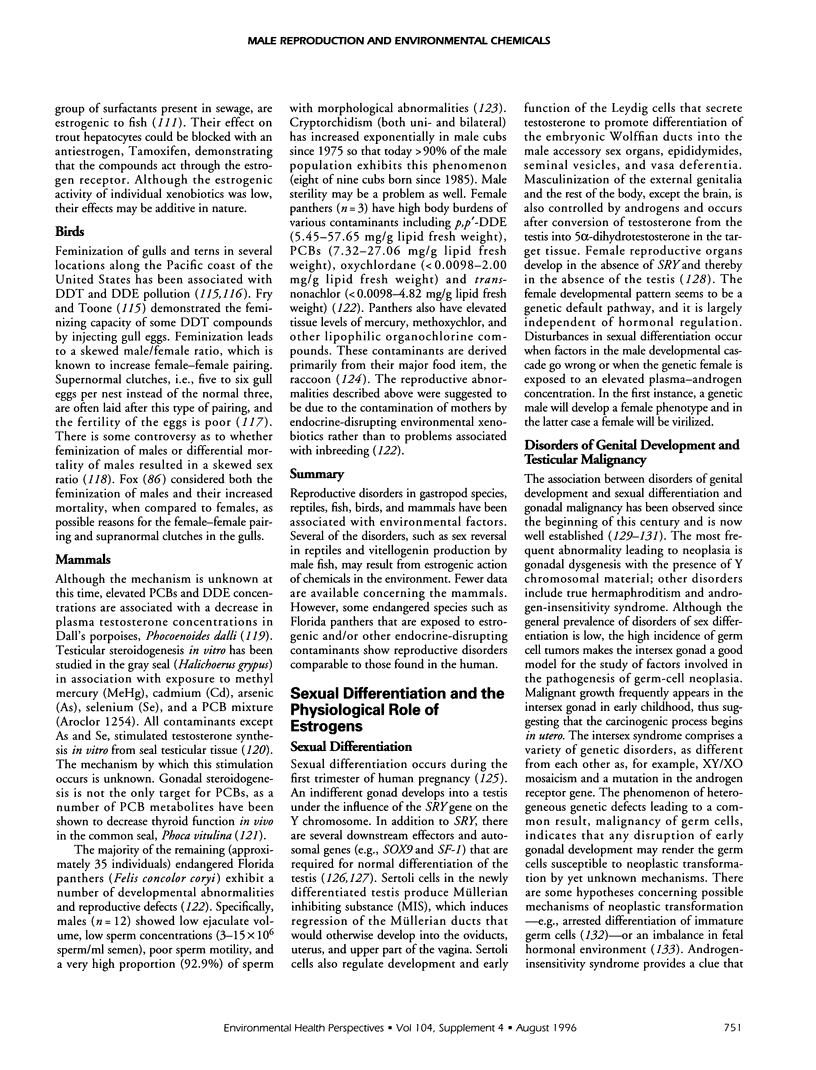






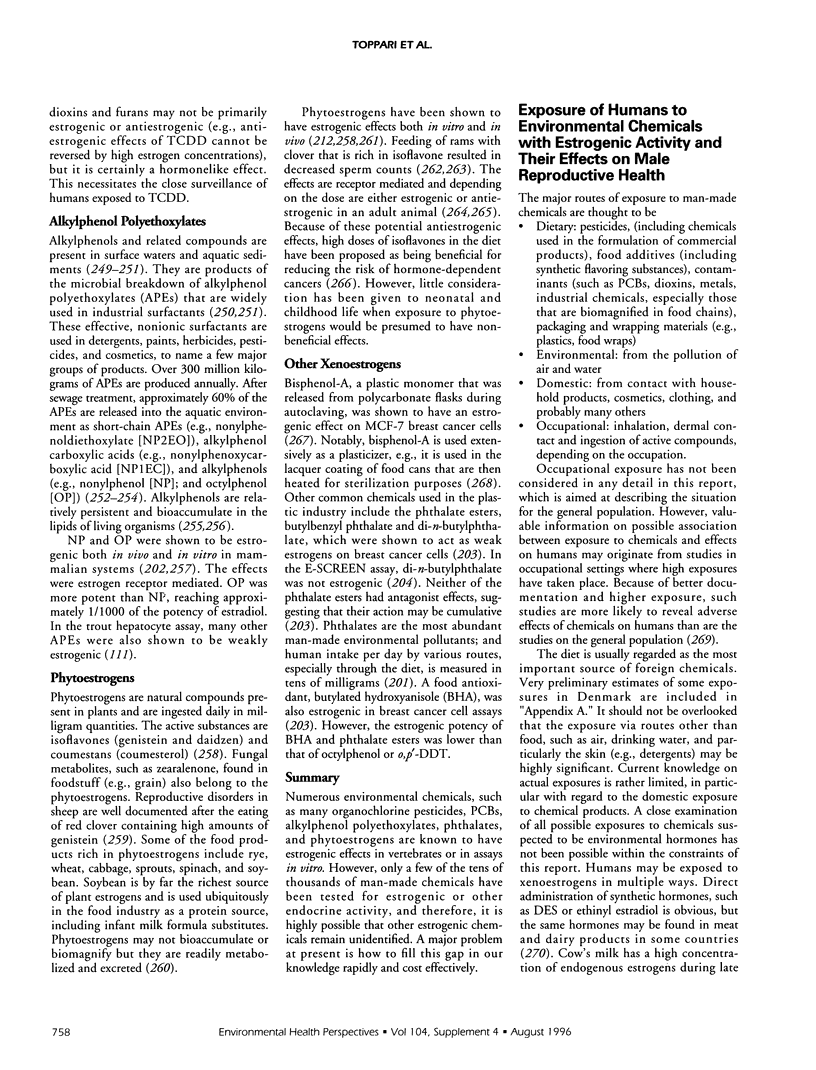


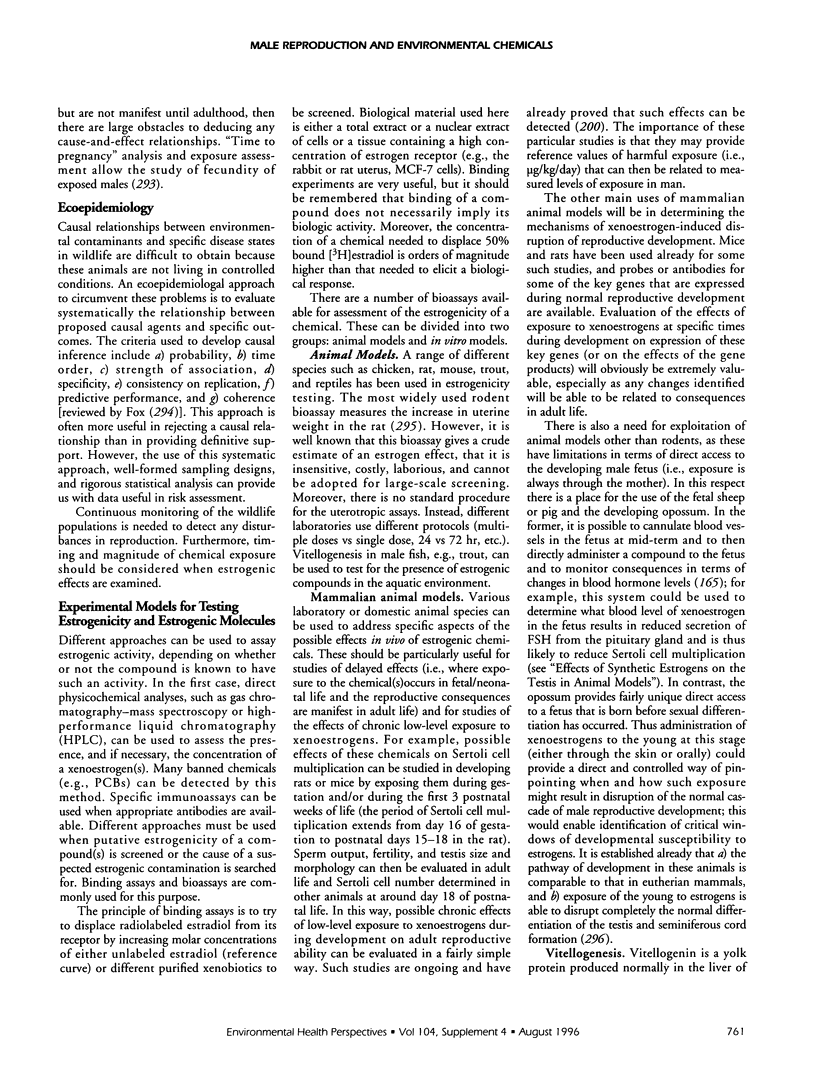





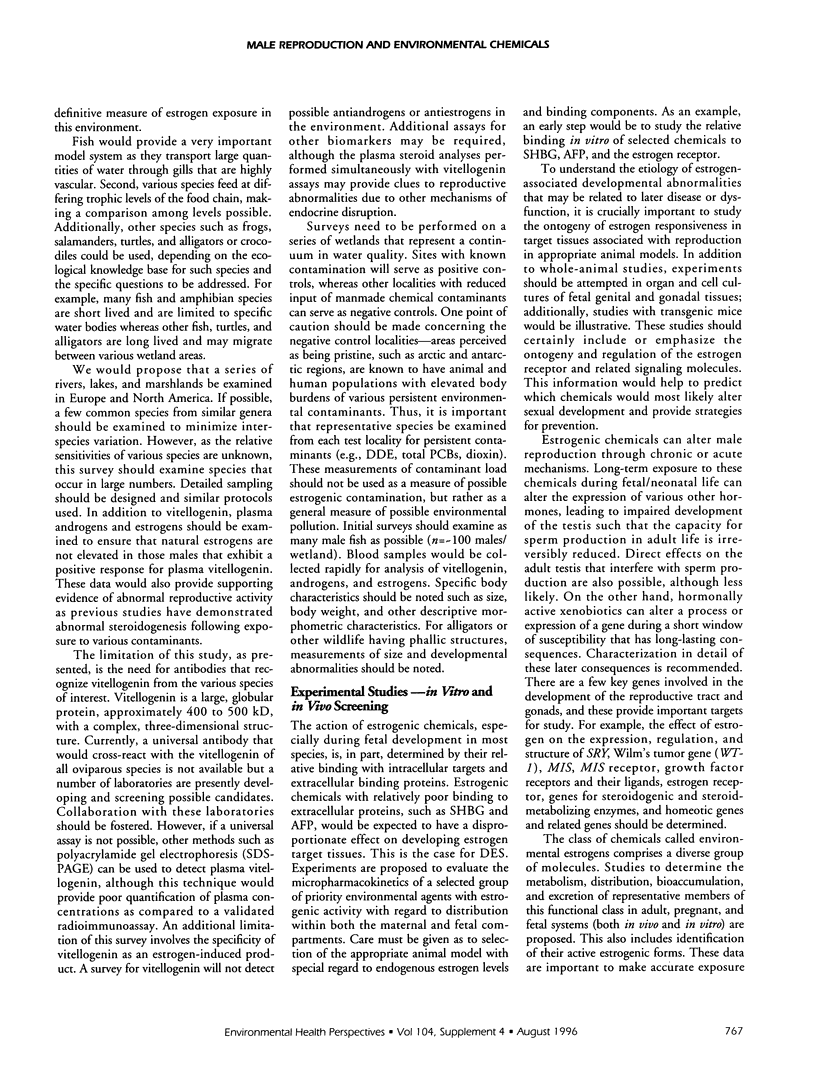

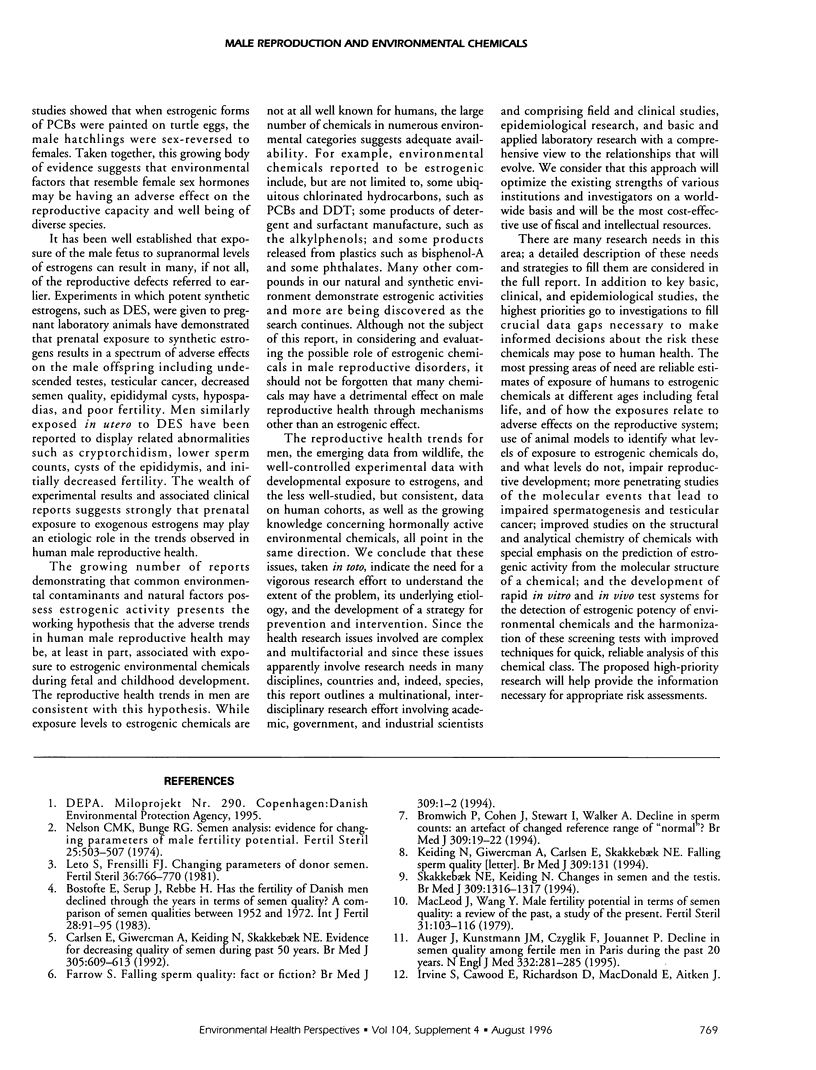









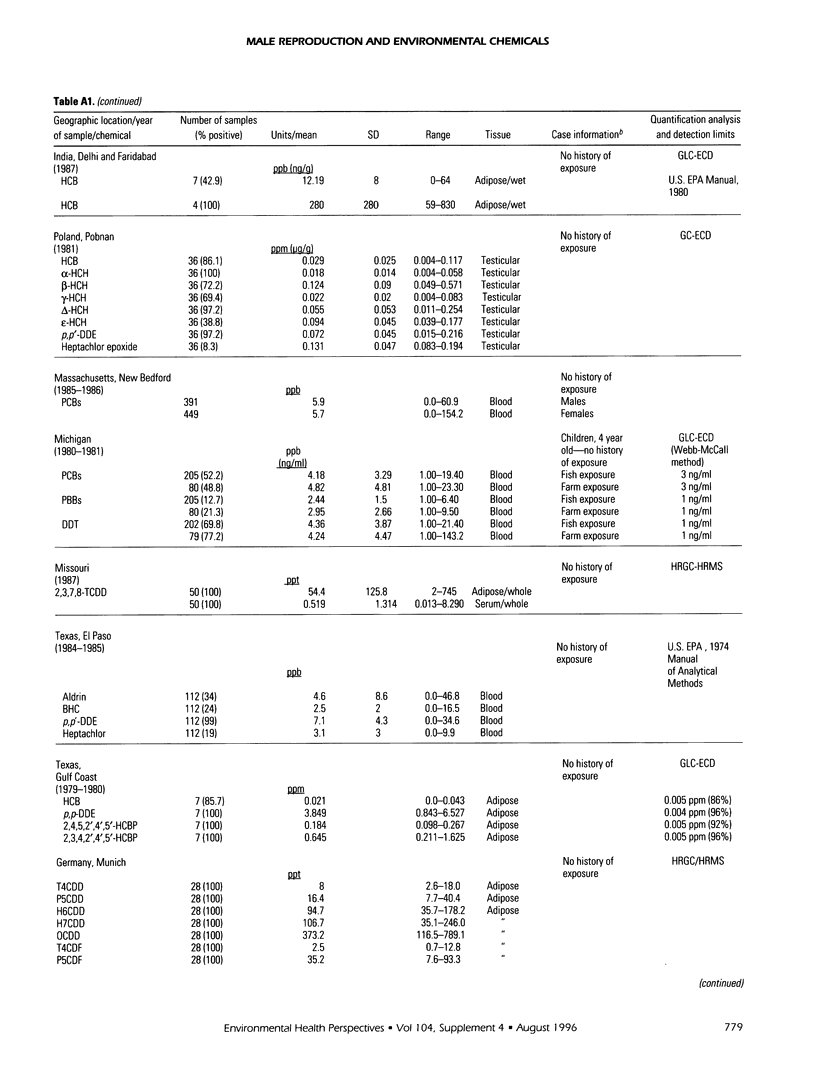

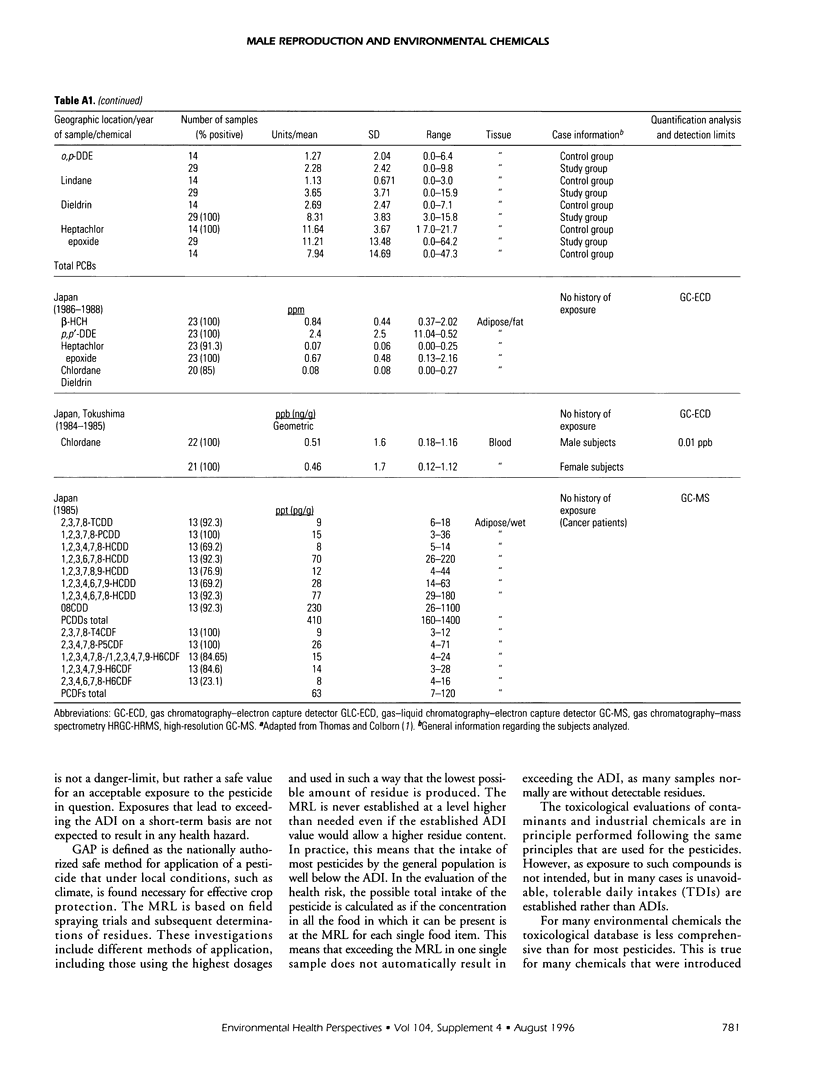
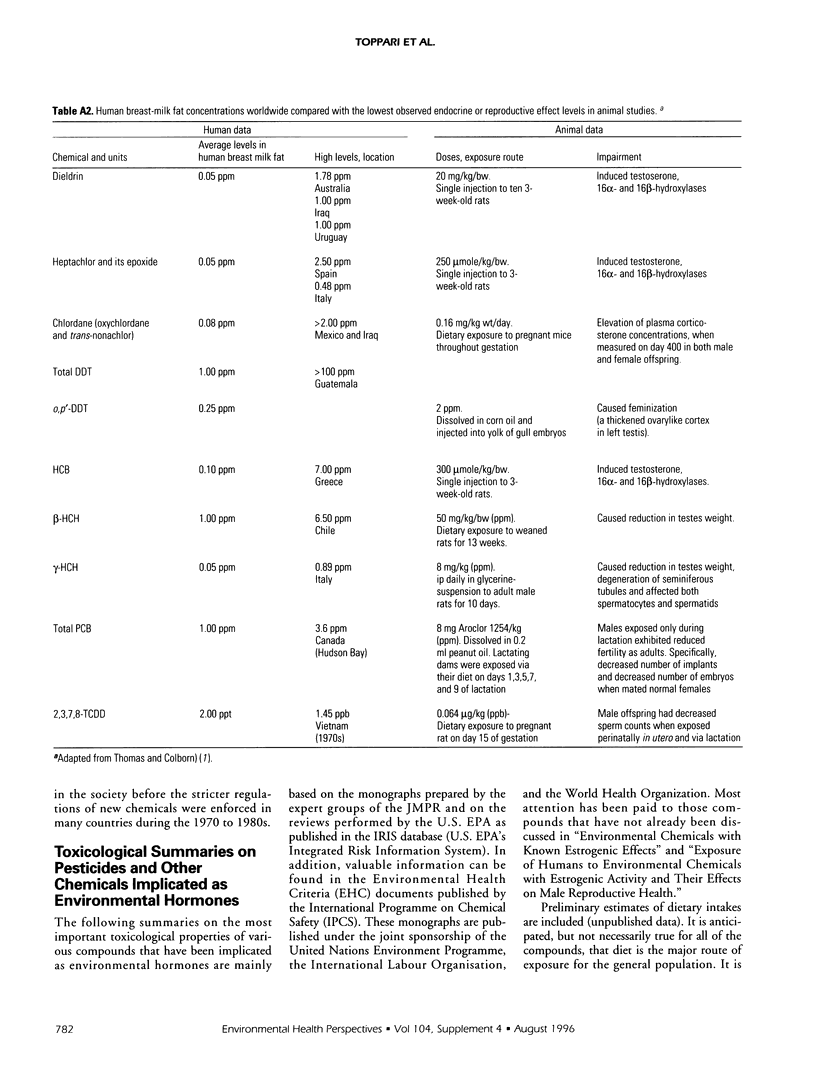







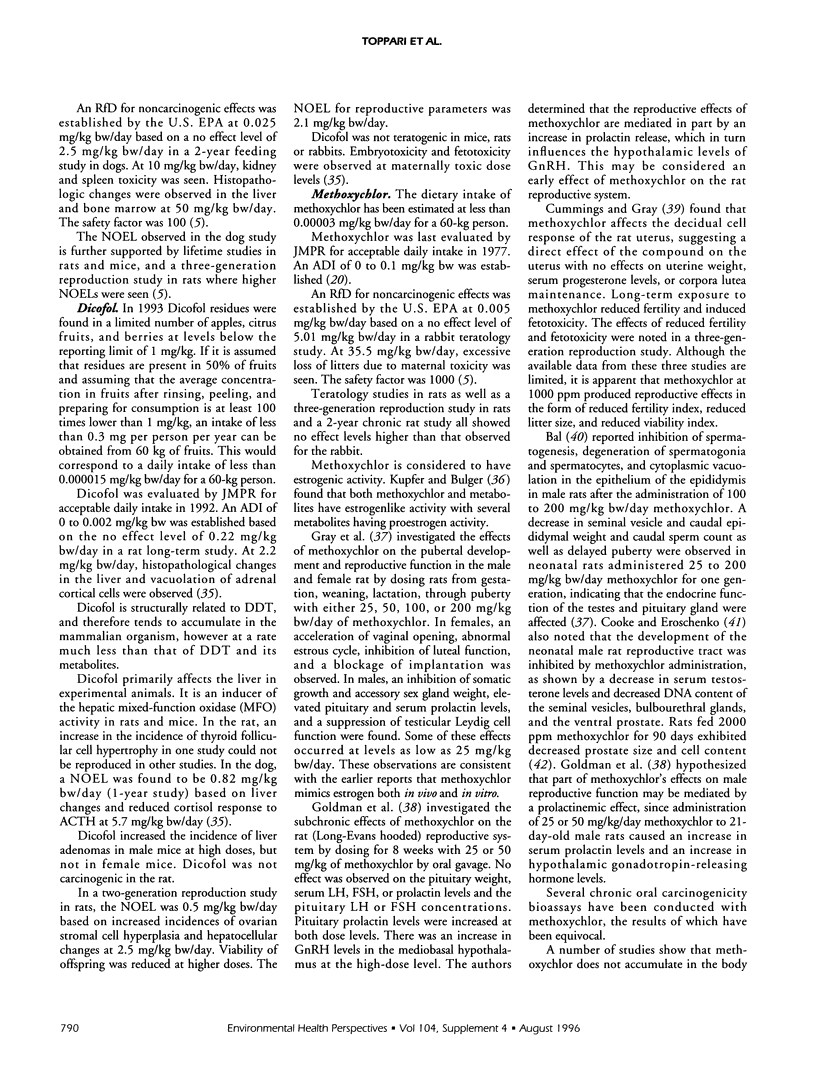



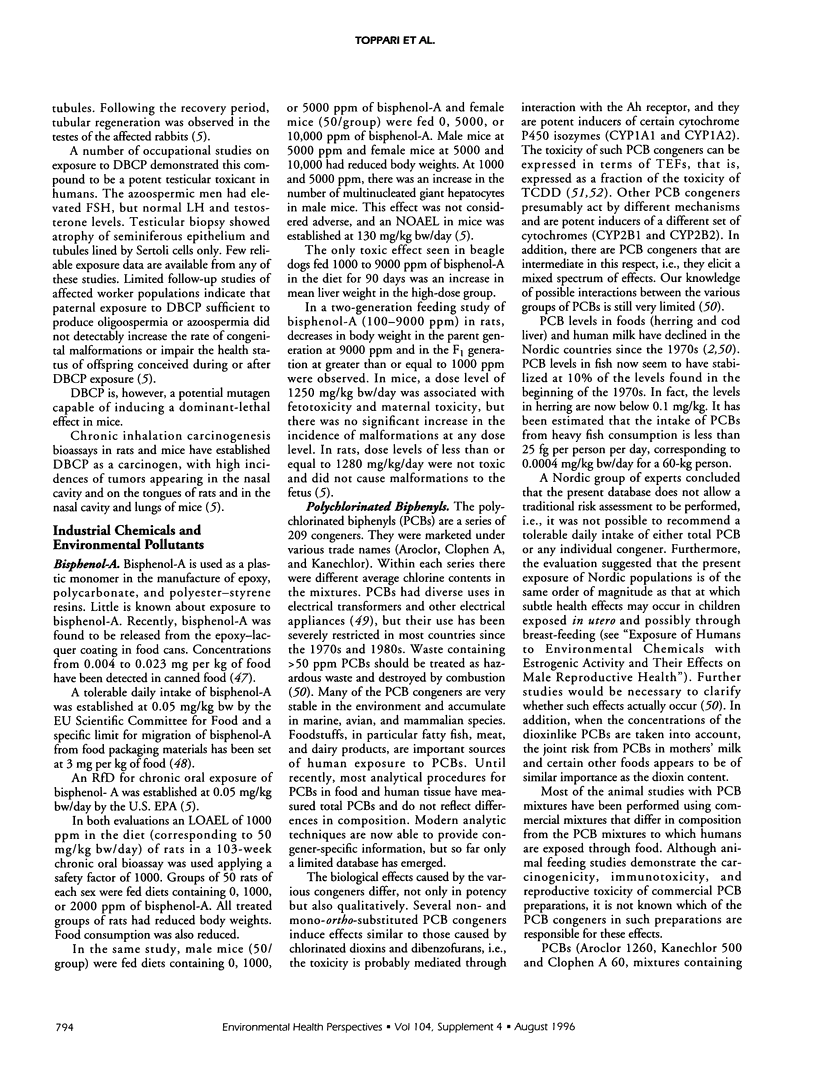


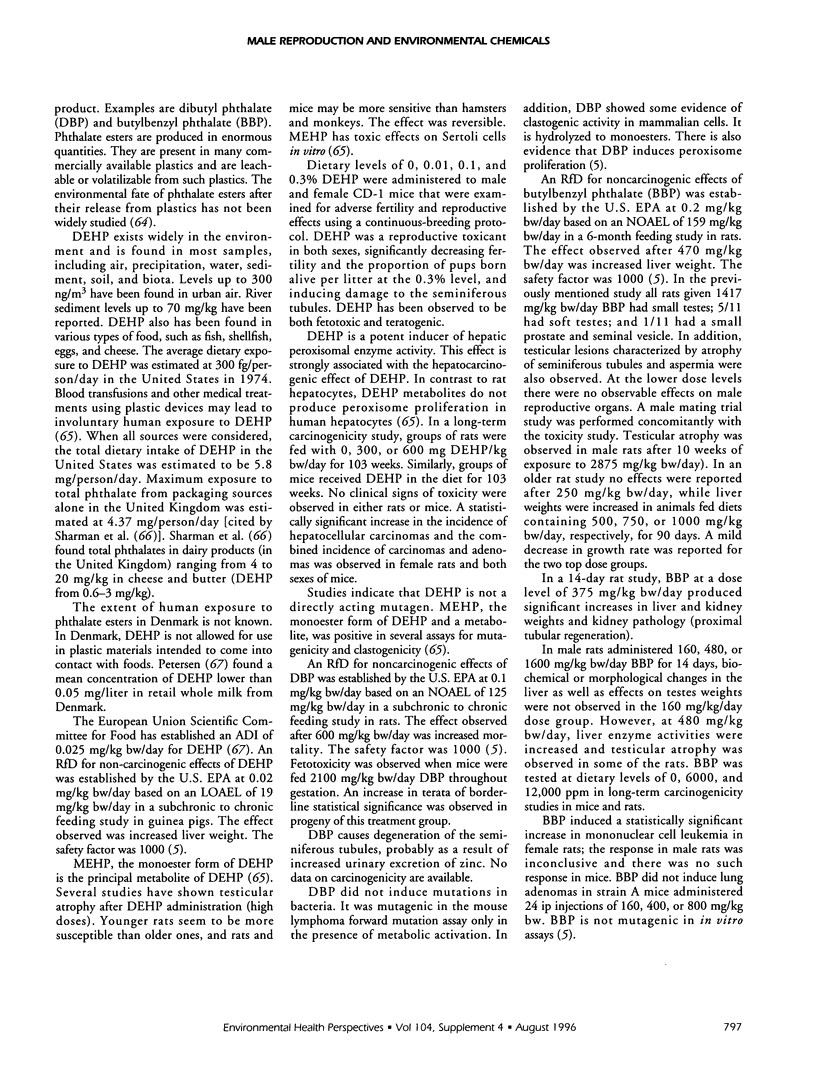


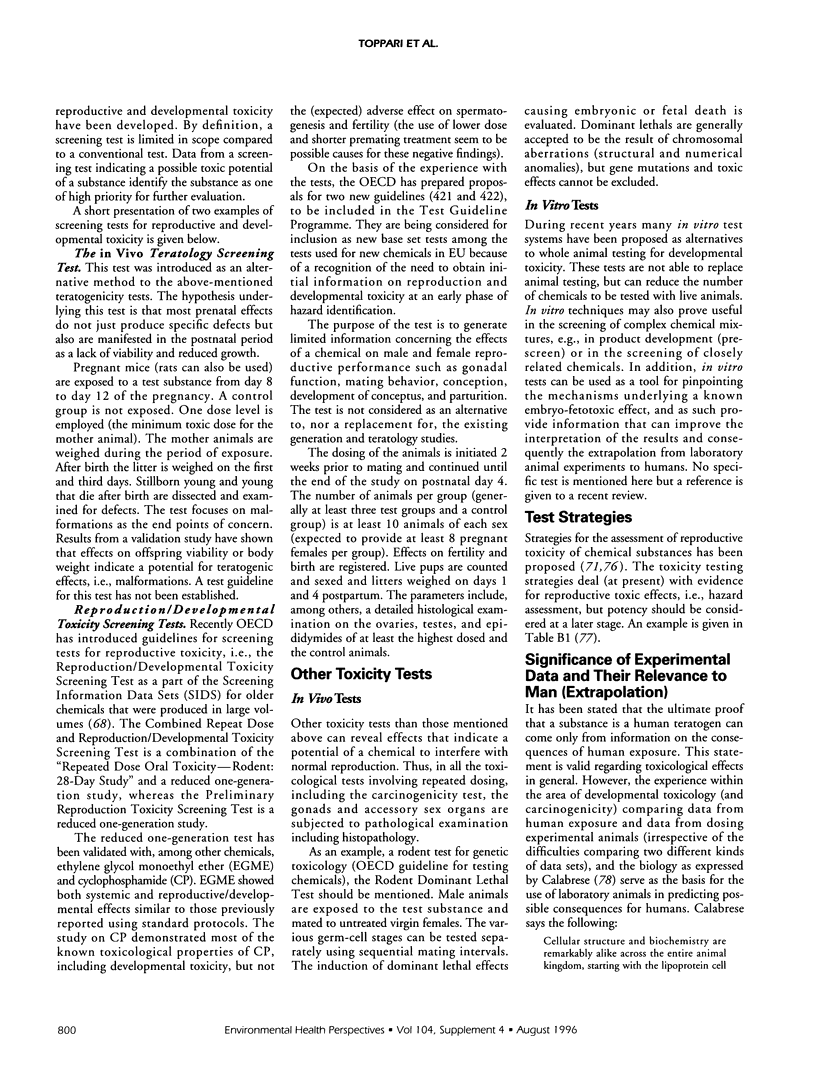
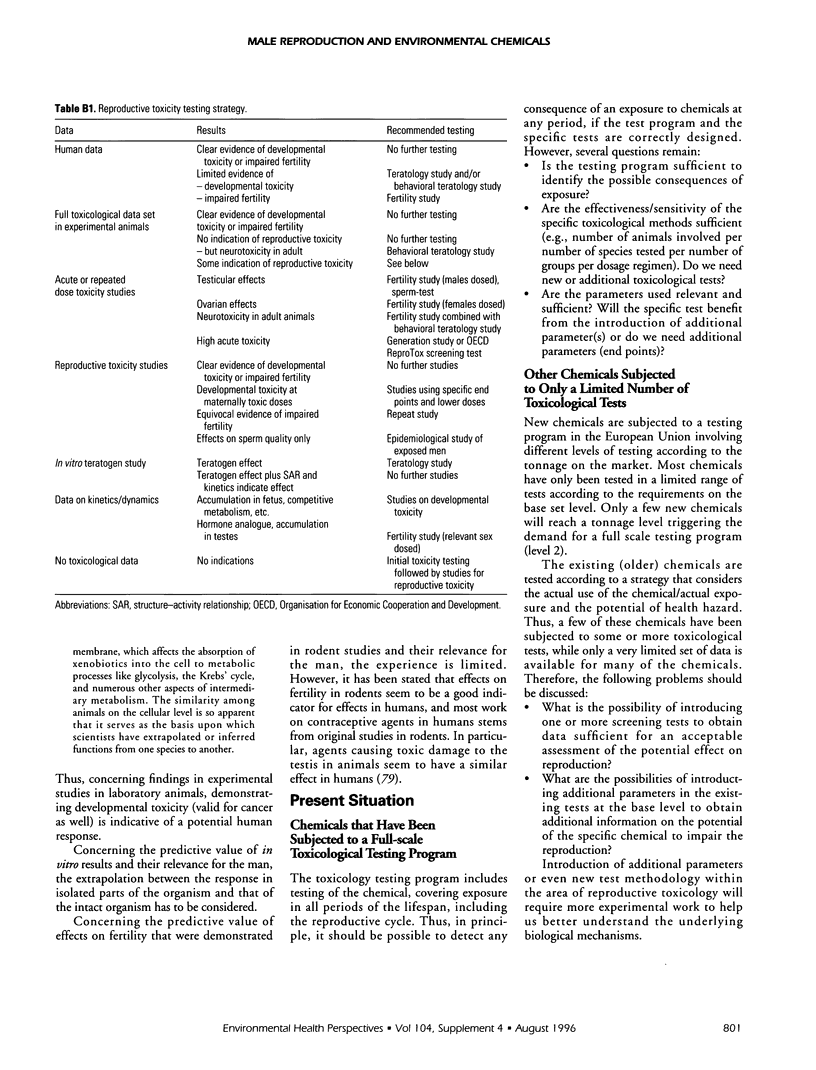
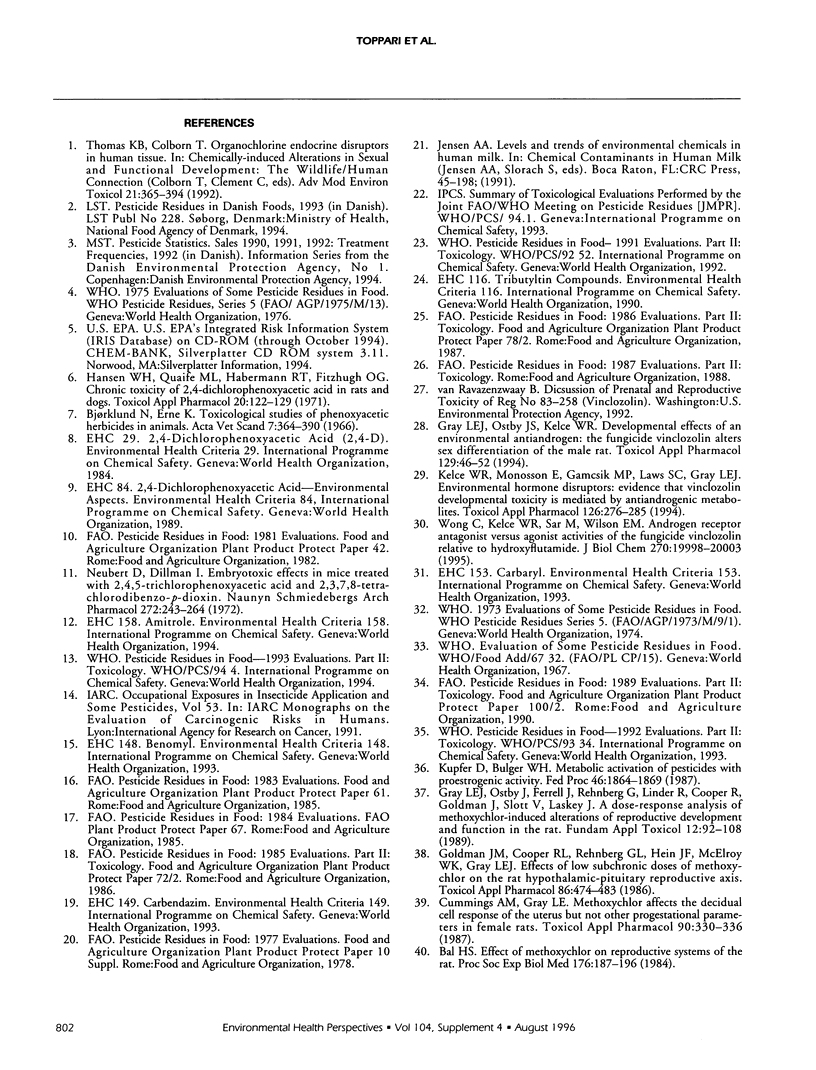

Images in this article
Selected References
These references are in PubMed. This may not be the complete list of references from this article.
- Adami H. O., Bergström R., Möhner M., Zatoński W., Storm H., Ekbom A., Tretli S., Teppo L., Ziegler H., Rahu M. Testicular cancer in nine northern European countries. Int J Cancer. 1994 Oct 1;59(1):33–38. doi: 10.1002/ijc.2910590108. [DOI] [PubMed] [Google Scholar]
- Adlercreutz H. Diet, breast cancer, and sex hormone metabolism. Ann N Y Acad Sci. 1990;595:281–290. doi: 10.1111/j.1749-6632.1990.tb34302.x. [DOI] [PubMed] [Google Scholar]
- Adlercreutz H., van der Wildt J., Kinzel J., Attalla H., Wähälä K., Mäkelä T., Hase T., Fotsis T. Lignan and isoflavonoid conjugates in human urine. J Steroid Biochem Mol Biol. 1995 Jan;52(1):97–103. doi: 10.1016/0960-0760(94)00146-d. [DOI] [PubMed] [Google Scholar]
- Ahel M., McEvoy J., Giger W. Bioaccumulation of the lipophilic metabolites of nonionic surfactants in freshwater organisms. Environ Pollut. 1993;79(3):243–248. doi: 10.1016/0269-7491(93)90096-7. [DOI] [PubMed] [Google Scholar]
- Andonian R. W., Kessler R. Transplacental exposure to diethylstilbestrol in men. Urology. 1979 Mar;13(3):276–279. doi: 10.1016/0090-4295(79)90420-5. [DOI] [PubMed] [Google Scholar]
- Arai Y., Mori T., Suzuki Y., Bern H. A. Long-term effects of perinatal exposure to sex steroids and diethylstilbestrol on the reproductive system of male mammals. Int Rev Cytol. 1983;84:235–268. doi: 10.1016/s0074-7696(08)61019-0. [DOI] [PubMed] [Google Scholar]
- Arnold D. L., Moodie C. A., Charbonneau S. M., Grice H. C., McGuire P. F., Bryce F. R., Collins B. T., Zawidzka Z. Z., Krewski D. R., Nera E. A. Long-term toxicity of hexachlorobenzene in the rat and the effect of dietary vitamin A. Food Chem Toxicol. 1985 Sep;23(9):779–793. doi: 10.1016/0278-6915(85)90278-9. [DOI] [PubMed] [Google Scholar]
- Auger J., Kunstmann J. M., Czyglik F., Jouannet P. Decline in semen quality among fertile men in Paris during the past 20 years. N Engl J Med. 1995 Feb 2;332(5):281–285. doi: 10.1056/NEJM199502023320501. [DOI] [PubMed] [Google Scholar]
- Avellán L. The incidence of hypospadias in Sweden. Scand J Plast Reconstr Surg. 1975;9(2):129–139. doi: 10.3109/02844317509022777. [DOI] [PubMed] [Google Scholar]
- BRADBURY R. B., WHITE D. E. Estrogens and related substances in plants. Vitam Horm. 1954;12:207–233. doi: 10.1016/s0083-6729(08)61013-4. [DOI] [PubMed] [Google Scholar]
- BUEMANN B., HENRIKSEN H., VILLUMSEN A. L., WESTH A., ZACHAU-CHRISTIANSEN B. Incidence of undescended testis in the newborn. Acta Chir Scand Suppl. 1961;Suppl 283:289–293. [PubMed] [Google Scholar]
- Baird D. D., Umbach D. M., Lansdell L., Hughes C. L., Setchell K. D., Weinberg C. R., Haney A. F., Wilcox A. J., Mclachlan J. A. Dietary intervention study to assess estrogenicity of dietary soy among postmenopausal women. J Clin Endocrinol Metab. 1995 May;80(5):1685–1690. doi: 10.1210/jcem.80.5.7745019. [DOI] [PubMed] [Google Scholar]
- Bal H. S. Effect of methoxychlor on reproductive systems of the rat. Proc Soc Exp Biol Med. 1984 Jun;176(2):187–196. doi: 10.3181/00379727-176-41861. [DOI] [PubMed] [Google Scholar]
- Balash K. J., Al-Omar M. A., Abdul Latif B. M. Effect of chlordane on testicular tissues of Swiss mice. Bull Environ Contam Toxicol. 1987 Sep;39(3):434–442. doi: 10.1007/BF01688307. [DOI] [PubMed] [Google Scholar]
- Beard C. M., Melton L. J., 3rd, O'Fallon W. M., Noller K. L., Benson R. C. Cryptorchism and maternal estrogen exposure. Am J Epidemiol. 1984 Nov;120(5):707–716. doi: 10.1093/oxfordjournals.aje.a113938. [DOI] [PubMed] [Google Scholar]
- Benson R. C., Jr, Beard C. M., Kelalis P. P., Kurland L. T. Malignant potential of the cryptorchid testis. Mayo Clin Proc. 1991 Apr;66(4):372–378. doi: 10.1016/s0025-6196(12)60660-0. [DOI] [PubMed] [Google Scholar]
- Bergeron J. M., Crews D., McLachlan J. A. PCBs as environmental estrogens: turtle sex determination as a biomarker of environmental contamination. Environ Health Perspect. 1994 Sep;102(9):780–781. doi: 10.1289/ehp.94102780. [DOI] [PMC free article] [PubMed] [Google Scholar]
- Berkovitz G. D. Abnormalities of gonadal determination and differentiation. Semin Perinatol. 1992 Oct;16(5):289–298. [PubMed] [Google Scholar]
- Berkowitz G. S., Lapinski R. H., Dolgin S. E., Gazella J. G., Bodian C. A., Holzman I. R. Prevalence and natural history of cryptorchidism. Pediatrics. 1993 Jul;92(1):44–49. [PubMed] [Google Scholar]
- Bertazzi P. A., Zocchetti C., Pesatori A. C., Guercilena S., Sanarico M., Radice L. Ten-year mortality study of the population involved in the Seveso incident in 1976. Am J Epidemiol. 1989 Jun;129(6):1187–1200. doi: 10.1093/oxfordjournals.aje.a115240. [DOI] [PubMed] [Google Scholar]
- Bibbo M., Gill W. B., Azizi F., Blough R., Fang V. S., Rosenfield R. L., Schumacher G. F., Sleeper K., Sonek M. G., Wied G. L. Follow-up study of male and female offspring of DES-exposed mothers. Obstet Gynecol. 1977 Jan;49(1):1–8. [PubMed] [Google Scholar]
- Bigler W. J., Jenkins J. H., Cumbie P. M., Hoff G. L., Prather E. C. Wildlife and environmental health: raccoons as indicators of zoonoses and pollutants in southeastern United States. J Am Vet Med Assoc. 1975 Oct 1;167(7):592–597. [PubMed] [Google Scholar]
- Bitman J., Cecil H. C. Estrogenic activity of DDT analogs and polychlorinated biphenyls. J Agric Food Chem. 1970 Nov-Dec;18(6):1108–1112. doi: 10.1021/jf60172a019. [DOI] [PubMed] [Google Scholar]
- Bitman J., Cecil H. C., Harris S. J., Fries G. F. Estrogenic activity of o,p'-DDT in the mammalian uterus and avian oviduct. Science. 1968 Oct 18;162(3851):371–372. doi: 10.1126/science.162.3851.371. [DOI] [PubMed] [Google Scholar]
- Bjerkedal T., Bakketeig L. S. Surveillance of congenital malformations and other conditions of the newborn. Int J Epidemiol. 1975 Mar;4(1):31–36. doi: 10.1093/ije/4.1.31. [DOI] [PubMed] [Google Scholar]
- Björklund N. E., Erne K. Toxicological studies of phenoxyacetic herbicides in animals. Acta Vet Scand. 1966;7(4):364–390. doi: 10.1186/BF03547123. [DOI] [PMC free article] [PubMed] [Google Scholar]
- Blom K. Retentio testis og tidspunkt for spontan descensus hos 2.516 skoledrenge. Ugeskr Laeger. 1984 Feb 20;146(8):616–617. [PubMed] [Google Scholar]
- Bostofte E., Serup J., Rebbe H. Has the fertility of Danish men declined through the years in terms of semen quality? A comparison of semen qualities between 1952 and 1972. Int J Fertil. 1983;28(2):91–95. [PubMed] [Google Scholar]
- Boyle P., Kaye S. B., Robertson A. G. Changes in testicular cancer in Scotland. Eur J Cancer Clin Oncol. 1987 Jun;23(6):827–830. doi: 10.1016/0277-5379(87)90286-0. [DOI] [PubMed] [Google Scholar]
- Brackbill Y., Berendes H. W. Dangers of diethylstilboestrol: Review of a 1953 paper. Lancet. 1978 Sep 2;2(8088):520–520. doi: 10.1016/s0140-6736(78)92237-7. [DOI] [PubMed] [Google Scholar]
- Brinster R. L., Avarbock M. R. Germline transmission of donor haplotype following spermatogonial transplantation. Proc Natl Acad Sci U S A. 1994 Nov 22;91(24):11303–11307. doi: 10.1073/pnas.91.24.11303. [DOI] [PMC free article] [PubMed] [Google Scholar]
- Brinster R. L., Zimmermann J. W. Spermatogenesis following male germ-cell transplantation. Proc Natl Acad Sci U S A. 1994 Nov 22;91(24):11298–11302. doi: 10.1073/pnas.91.24.11298. [DOI] [PMC free article] [PubMed] [Google Scholar]
- Bromwich P., Cohen J., Stewart I., Walker A. Decline in sperm counts: an artefact of changed reference range of "normal"? BMJ. 1994 Jul 2;309(6946):19–22. doi: 10.1136/bmj.309.6946.19. [DOI] [PMC free article] [PubMed] [Google Scholar]
- Brotons J. A., Olea-Serrano M. F., Villalobos M., Pedraza V., Olea N. Xenoestrogens released from lacquer coatings in food cans. Environ Health Perspect. 1995 Jun;103(6):608–612. doi: 10.1289/ehp.95103608. [DOI] [PMC free article] [PubMed] [Google Scholar]
- Brotons J. A., Olea-Serrano M. F., Villalobos M., Pedraza V., Olea N. Xenoestrogens released from lacquer coatings in food cans. Environ Health Perspect. 1995 Jun;103(6):608–612. doi: 10.1289/ehp.95103608. [DOI] [PMC free article] [PubMed] [Google Scholar]
- Brown-Grant K., Fink G., Greig F., Murray M. A. Altered sexual development in male rats after oestrogen administration during the neonatal period. J Reprod Fertil. 1975 Jul;44(1):25–42. doi: 10.1530/jrf.0.0440025. [DOI] [PubMed] [Google Scholar]
- Brown L. M., Pottern L. M., Hoover R. N. Prenatal and perinatal risk factors for testicular cancer. Cancer Res. 1986 Sep;46(9):4812–4816. [PubMed] [Google Scholar]
- Bujan L., Mansat A., Pontonnier F., Mieusset R. Time series analysis of sperm concentration in fertile men in Toulouse, France between 1977 and 1992. BMJ. 1996 Feb 24;312(7029):471–472. doi: 10.1136/bmj.312.7029.471. [DOI] [PMC free article] [PubMed] [Google Scholar]
- Bulger W. H., Kupfer D. Estrogenic action of DDT analogs. Am J Ind Med. 1983;4(1-2):163–173. [PubMed] [Google Scholar]
- Bulger W. H., Muccitelli R. M., Kupfer D. Studies on the in vivo and in vitro estrogenic activities of methoxychlor and its metabolites. Role of hepatic mono-oxygenase in methoxychlor activation. Biochem Pharmacol. 1978;27(20):2417–2423. doi: 10.1016/0006-2952(78)90354-4. [DOI] [PubMed] [Google Scholar]
- Bull J. J., Gutzke W. H., Crews D. Sex reversal by estradiol in three reptilian orders. Gen Comp Endocrinol. 1988 Jun;70(3):425–428. doi: 10.1016/0016-6480(88)90117-7. [DOI] [PubMed] [Google Scholar]
- Bush B., Bennett A. H., Snow J. T. Polychlorobiphenyl congeners, p,p'-DDE, and sperm function in humans. Arch Environ Contam Toxicol. 1986 Jul;15(4):333–341. doi: 10.1007/BF01066399. [DOI] [PubMed] [Google Scholar]
- Bustos S., Denegri J. C., Diaz F., Tchernitchin A. N. p,p'-DDT is an estrogenic compound. Bull Environ Contam Toxicol. 1988 Oct;41(4):496–501. doi: 10.1007/BF02020992. [DOI] [PubMed] [Google Scholar]
- Carlsen E., Giwercman A., Keiding N., Skakkebaek N. E. Evidence for decreasing quality of semen during past 50 years. BMJ. 1992 Sep 12;305(6854):609–613. doi: 10.1136/bmj.305.6854.609. [DOI] [PMC free article] [PubMed] [Google Scholar]
- Cassidy A., Bingham S., Setchell K. D. Biological effects of a diet of soy protein rich in isoflavones on the menstrual cycle of premenopausal women. Am J Clin Nutr. 1994 Sep;60(3):333–340. doi: 10.1093/ajcn/60.3.333. [DOI] [PubMed] [Google Scholar]
- Chilvers C., Pike M. C., Forman D., Fogelman K., Wadsworth M. E. Apparent doubling of frequency of undescended testis in England and Wales in 1962-81. Lancet. 1984 Aug 11;2(8398):330–332. doi: 10.1016/s0140-6736(84)92697-7. [DOI] [PubMed] [Google Scholar]
- Choi H., Kim K. M., Koh S. K., Kim K. S., Woo Y. N., Yoon J. B., Choi S. K., Kim S. W. A survey of externally recognizable genitourinary anomalies in Korean newborns. Korean Urological Association. J Korean Med Sci. 1989 Mar;4(1):13–21. doi: 10.3346/jkms.1989.4.1.13. [DOI] [PMC free article] [PubMed] [Google Scholar]
- Chung C. S., Myrianthopoulos N. C. Racial and prenatal factors in major congenital malformations. Am J Hum Genet. 1968 Jan;20(1):44–60. [PMC free article] [PubMed] [Google Scholar]
- Chvapil M., Eskelson C. D., Stiffel V., Owen J. A., Droegemueller W. Studies on Nonoxynol-9. II. Intravaginal absorption, distribution, metabolism and excretion in rats and rabbits. Contraception. 1980 Sep;22(3):325–339. doi: 10.1016/s0010-7824(80)80010-2. [DOI] [PubMed] [Google Scholar]
- Clemens M. J. The regulation of egg yolk protein synthesis by steroid hormones. Prog Biophys Mol Biol. 1974;28:69–108. doi: 10.1016/0079-6107(74)90017-0. [DOI] [PubMed] [Google Scholar]
- Colborn T., vom Saal F. S., Soto A. M. Developmental effects of endocrine-disrupting chemicals in wildlife and humans. Environ Health Perspect. 1993 Oct;101(5):378–384. doi: 10.1289/ehp.93101378. [DOI] [PMC free article] [PubMed] [Google Scholar]
- Conley G. R., Sant G. R., Ucci A. A., Mitcheson H. D. Seminoma and epididymal cysts in a young man with known diethylstilbestrol exposure in utero. JAMA. 1983 Mar 11;249(10):1325–1326. [PubMed] [Google Scholar]
- Cooke P. S., Eroschenko V. P. Inhibitory effects of technical grade methoxychlor on development of neonatal male mouse reproductive organs. Biol Reprod. 1990 Mar;42(3):585–596. doi: 10.1095/biolreprod42.3.585. [DOI] [PubMed] [Google Scholar]
- Cooper R. L., Chadwick R. W., Rehnberg G. L., Goldman J. M., Booth K. C., Hein J. F., McElroy W. K. Effect of lindane on hormonal control of reproductive function in the female rat. Toxicol Appl Pharmacol. 1989 Jul;99(3):384–394. doi: 10.1016/0041-008x(89)90148-8. [DOI] [PubMed] [Google Scholar]
- Copeland P. A., Sumpter J. P., Walker T. K., Croft M. Vitellogenin levels in male and female rainbow trout (Salmo gairdneri Richardson) at various stages of the reproductive cycle. Comp Biochem Physiol B. 1986;83(2):487–493. doi: 10.1016/0305-0491(86)90400-1. [DOI] [PubMed] [Google Scholar]
- Correy J. F., Newman N. M., Collins J. A., Burrows E. A., Burrows R. F., Curran J. T. Use of prescription drugs in the first trimester and congenital malformations. Aust N Z J Obstet Gynaecol. 1991 Nov;31(4):340–344. doi: 10.1111/j.1479-828x.1991.tb02816.x. [DOI] [PubMed] [Google Scholar]
- Cour-Palais I. J. Spontaneous descent of the testicle. Lancet. 1966 Jun 25;1(7452):1403–1405. doi: 10.1016/s0140-6736(66)90306-0. [DOI] [PubMed] [Google Scholar]
- Cummings A. M., Gray L. E., Jr Methoxychlor affects the decidual cell response of the uterus but not other progestational parameters in female rats. Toxicol Appl Pharmacol. 1987 Sep 15;90(2):330–336. doi: 10.1016/0041-008x(87)90340-1. [DOI] [PubMed] [Google Scholar]
- Czeizel A., Erödi E., Tóth J. An epidemiological study on undescended testis. J Urol. 1981 Oct;126(4):524–527. doi: 10.1016/s0022-5347(17)54609-1. [DOI] [PubMed] [Google Scholar]
- Czeizel A. Increasing trends in congenital malformations of male external genitalia. Lancet. 1985 Feb 23;1(8426):462–463. doi: 10.1016/s0140-6736(85)91185-7. [DOI] [PubMed] [Google Scholar]
- Czeizel A., Tóth J., Czvenits E. Increased birth prevalence of isolated hypospadias in Hungary. Acta Paediatr Hung. 1986;27(4):329–337. [PubMed] [Google Scholar]
- DIECKMANN W. J., DAVIS M. E., RYNKIEWICZ L. M., POTTINGER R. E. Does the administration of diethylstilbestrol during pregnancy have therapeutic value? Am J Obstet Gynecol. 1953 Nov;66(5):1062–1081. doi: 10.1016/s0002-9378(16)38617-3. [DOI] [PubMed] [Google Scholar]
- Davis D. L., Bradlow H. L., Wolff M., Woodruff T., Hoel D. G., Anton-Culver H. Medical hypothesis: xenoestrogens as preventable causes of breast cancer. Environ Health Perspect. 1993 Oct;101(5):372–377. doi: 10.1289/ehp.93101372. [DOI] [PMC free article] [PubMed] [Google Scholar]
- Davis V. L., Couse J. F., Goulding E. H., Power S. G., Eddy E. M., Korach K. S. Aberrant reproductive phenotypes evident in transgenic mice expressing the wild-type mouse estrogen receptor. Endocrinology. 1994 Jul;135(1):379–386. doi: 10.1210/endo.135.1.8013372. [DOI] [PubMed] [Google Scholar]
- Depue R. H., Pike M. C., Henderson B. E. Estrogen exposure during gestation and risk of testicular cancer. J Natl Cancer Inst. 1983 Dec;71(6):1151–1155. [PubMed] [Google Scholar]
- Dickman Z., Day S. K. Proceedings: Two theories: the preimplantation embryo is a source of steroid hormones controlling (1) morula-blastocyst transformation and (2) implantation. J Reprod Fertil. 1973 Dec;35(3):615–617. doi: 10.1530/jrf.0.0350615. [DOI] [PubMed] [Google Scholar]
- Driscoll S. G., Taylor S. H. Effects of prenatal maternal estrogen on the male urogenital system. Obstet Gynecol. 1980 Nov;56(5):537–542. [PubMed] [Google Scholar]
- Ekelund R., Bergman A., Granmo A., Berggren M. Bioaccumulation of 4-nonylphenol in marine animals--a re-evaluation. Environ Pollut. 1990;64(2):107–120. doi: 10.1016/0269-7491(90)90108-o. [DOI] [PubMed] [Google Scholar]
- Ewertz M., Holmberg L., Karjalainen S., Tretli S., Adami H. O. Incidence of male breast cancer in Scandinavia, 1943-1982. Int J Cancer. 1989 Jan 15;43(1):27–31. doi: 10.1002/ijc.2910430107. [DOI] [PubMed] [Google Scholar]
- Facemire C. F., Gross T. S., Guillette L. J., Jr Reproductive impairment in the Florida panther: nature or nurture? Environ Health Perspect. 1995 May;103 (Suppl 4):79–86. doi: 10.1289/ehp.103-1519283. [DOI] [PMC free article] [PubMed] [Google Scholar]
- Farrow S. Falling sperm quality: fact or fiction? BMJ. 1994 Jul 2;309(6946):1–2. doi: 10.1136/bmj.309.6946.1. [DOI] [PMC free article] [PubMed] [Google Scholar]
- Fein G. G., Jacobson J. L., Jacobson S. W., Schwartz P. M., Dowler J. K. Prenatal exposure to polychlorinated biphenyls: effects on birth size and gestational age. J Pediatr. 1984 Aug;105(2):315–320. doi: 10.1016/s0022-3476(84)80139-0. [DOI] [PubMed] [Google Scholar]
- Finley W. H., Gustavson K. H., Hall T. M., Hurst D. C., Barganier C. M., Wiedmeyer J. A. Birth defects surveillance: Jefferson County, Alabama, and Uppsala County, Sweden. South Med J. 1994 Apr;87(4):440–445. doi: 10.1097/00007611-199404000-00004. [DOI] [PubMed] [Google Scholar]
- Forman D., Møller H. Testicular cancer. Cancer Surv. 1994;19-20:323–341. [PubMed] [Google Scholar]
- Foster J. W., Dominguez-Steglich M. A., Guioli S., Kwok C., Weller P. A., Stevanović M., Weissenbach J., Mansour S., Young I. D., Goodfellow P. N. Campomelic dysplasia and autosomal sex reversal caused by mutations in an SRY-related gene. Nature. 1994 Dec 8;372(6506):525–530. doi: 10.1038/372525a0. [DOI] [PubMed] [Google Scholar]
- Fox G. A. Practical causal inference for ecoepidemiologists. J Toxicol Environ Health. 1991 Aug;33(4):359–373. doi: 10.1080/15287399109531535. [DOI] [PubMed] [Google Scholar]
- Freeman H. C., Sangalang G. B. A study of the effects of methyl mercury, cadmium, arsenic, selenium, and a PCB, (Aroclor 1254) on adrenal and testicular steroidogeneses in vitro, by the gray seal Halichoerus grypus. Arch Environ Contam Toxicol. 1977;5(3):369–383. doi: 10.1007/BF02220918. [DOI] [PubMed] [Google Scholar]
- Freeman H. C., Sangalang G., Flemming B. The sublethal effects of a polychlorinated biphenyl (Aroclor 1254) diet on the Atlantic cod (Gadus morhua). Sci Total Environ. 1982 May;24(1):1–11. doi: 10.1016/0048-9697(82)90053-5. [DOI] [PubMed] [Google Scholar]
- Fry D. M., Toone C. K. DDT-induced feminization of gull embryos. Science. 1981 Aug 21;213(4510):922–924. doi: 10.1126/science.7256288. [DOI] [PubMed] [Google Scholar]
- Gellert R. J., Heinrichs W. L., Swerdloff R. Effects of neonatally-administered DDT homologs on reproductive function in male and female rats. Neuroendocrinology. 1974;16(2):84–94. doi: 10.1159/000122555. [DOI] [PubMed] [Google Scholar]
- Gellert R. J., Wilson C. Reproductive function in rats exposed prenatally to pesticides and polychlorinated biphenyls (PCB). Environ Res. 1979 Apr;18(2):437–443. doi: 10.1016/0013-9351(79)90119-1. [DOI] [PubMed] [Google Scholar]
- George F. W., Wilson J. D. Estrogen formation in the early rabbit embryo. Science. 1978 Jan 13;199(4325):200–201. doi: 10.1126/science.579477. [DOI] [PubMed] [Google Scholar]
- Gershman S. T., Stolley P. D. A case-control study of testicular cancer using Connecticut tumour registry data. Int J Epidemiol. 1988 Dec;17(4):738–742. doi: 10.1093/ije/17.4.738. [DOI] [PubMed] [Google Scholar]
- Giger W., Brunner P. H., Schaffner C. 4-Nonylphenol in sewage sludge: accumulation of toxic metabolites from nonionic surfactants. Science. 1984 Aug 10;225(4662):623–625. doi: 10.1126/science.6740328. [DOI] [PubMed] [Google Scholar]
- Gill W. B., Schumacher G. F., Bibbo M. Pathological semen and anatomical abnormalities of the genital tract in human male subjects exposed to diethylstilbestrol in utero. J Urol. 1977 Apr;117(4):477–480. doi: 10.1016/s0022-5347(17)58502-x. [DOI] [PubMed] [Google Scholar]
- Gill W. B., Schumacher G. F., Bibbo M., Straus F. H., 2nd, Schoenberg H. W. Association of diethylstilbestrol exposure in utero with cryptorchidism, testicular hypoplasia and semen abnormalities. J Urol. 1979 Jul;122(1):36–39. doi: 10.1016/s0022-5347(17)56240-0. [DOI] [PubMed] [Google Scholar]
- Ginsburg J., Hardiman P. Decreasing quality of semen. BMJ. 1992 Nov 14;305(6863):1229–1229. doi: 10.1136/bmj.305.6863.1229. [DOI] [PMC free article] [PubMed] [Google Scholar]
- Goldman J. M., Cooper R. L., Rehnberg G. L., Hein J. F., McElroy W. K., Gray L. E., Jr Effects of low subchronic doses of methoxychlor on the rat hypothalamic-pituitary reproductive axis. Toxicol Appl Pharmacol. 1986 Dec;86(3):474–483. doi: 10.1016/0041-008x(86)90375-3. [DOI] [PubMed] [Google Scholar]
- Gray L. E., Jr Neonatal chlordecone exposure alters behavioral sex differentiation in female hamsters. Neurotoxicology. 1982 Oct;3(2):67–79. [PubMed] [Google Scholar]
- Gray L. E., Jr, Ostby J. S., Kelce W. R. Developmental effects of an environmental antiandrogen: the fungicide vinclozolin alters sex differentiation of the male rat. Toxicol Appl Pharmacol. 1994 Nov;129(1):46–52. doi: 10.1006/taap.1994.1227. [DOI] [PubMed] [Google Scholar]
- Gray L. E., Jr, Ostby J., Ferrell J., Rehnberg G., Linder R., Cooper R., Goldman J., Slott V., Laskey J. A dose-response analysis of methoxychlor-induced alterations of reproductive development and function in the rat. Fundam Appl Toxicol. 1989 Jan;12(1):92–108. doi: 10.1016/0272-0590(89)90065-1. [DOI] [PubMed] [Google Scholar]
- Gray L. E., Jr, Ostby J., Ferrell J., Rehnberg G., Linder R., Cooper R., Goldman J., Slott V., Laskey J. A dose-response analysis of methoxychlor-induced alterations of reproductive development and function in the rat. Fundam Appl Toxicol. 1989 Jan;12(1):92–108. doi: 10.1016/0272-0590(89)90065-1. [DOI] [PubMed] [Google Scholar]
- Greco T. L., Duello T. M., Gorski J. Estrogen receptors, estradiol, and diethylstilbestrol in early development: the mouse as a model for the study of estrogen receptors and estrogen sensitivity in embryonic development of male and female reproductive tracts. Endocr Rev. 1993 Feb;14(1):59–71. doi: 10.1210/edrv-14-1-59. [DOI] [PubMed] [Google Scholar]
- Greco T. L., Furlow J. D., Duello T. M., Gorski J. Immunodetection of estrogen receptors in fetal and neonatal male mouse reproductive tracts. Endocrinology. 1992 Jan;130(1):421–429. doi: 10.1210/endo.130.1.1727715. [DOI] [PubMed] [Google Scholar]
- Grosvenor C. E., Picciano M. F., Baumrucker C. R. Hormones and growth factors in milk. Endocr Rev. 1993 Dec;14(6):710–728. doi: 10.1210/edrv-14-6-710. [DOI] [PubMed] [Google Scholar]
- Guerrier D., Boussin L., Mader S., Josso N., Kahn A., Picard J. Y. Expression of the gene for anti-Müllerian hormone. J Reprod Fertil. 1990 Mar;88(2):695–706. doi: 10.1530/jrf.0.0880695. [DOI] [PubMed] [Google Scholar]
- Guillette L. J., Jr, Crain D. A., Rooney A. A., Pickford D. B. Organization versus activation: the role of endocrine-disrupting contaminants (EDCs) during embryonic development in wildlife. Environ Health Perspect. 1995 Oct;103 (Suppl 7):157–164. doi: 10.1289/ehp.95103s7157. [DOI] [PMC free article] [PubMed] [Google Scholar]
- Guillette L. J., Jr, Gross T. S., Gross D. A., Rooney A. A., Percival H. F. Gonadal steroidogenesis in vitro from juvenile alligators obtained from contaminated or control lakes. Environ Health Perspect. 1995 May;103 (Suppl 4):31–36. doi: 10.1289/ehp.95103s431. [DOI] [PMC free article] [PubMed] [Google Scholar]
- Guillette L. J., Jr, Gross T. S., Masson G. R., Matter J. M., Percival H. F., Woodward A. R. Developmental abnormalities of the gonad and abnormal sex hormone concentrations in juvenile alligators from contaminated and control lakes in Florida. Environ Health Perspect. 1994 Aug;102(8):680–688. doi: 10.1289/ehp.94102680. [DOI] [PMC free article] [PubMed] [Google Scholar]
- Guillette L. J., Jr, Pickford D. B., Crain D. A., Rooney A. A., Percival H. F. Reduction in penis size and plasma testosterone concentrations in juvenile alligators living in a contaminated environment. Gen Comp Endocrinol. 1996 Jan;101(1):32–42. doi: 10.1006/gcen.1996.0005. [DOI] [PubMed] [Google Scholar]
- Gutzke W. H., Bull J. J. Steroid hormones reverse sex in turtles. Gen Comp Endocrinol. 1986 Dec;64(3):368–372. doi: 10.1016/0016-6480(86)90070-5. [DOI] [PubMed] [Google Scholar]
- Guzelian P. S. Comparative toxicology of chlordecone (Kepone) in humans and experimental animals. Annu Rev Pharmacol Toxicol. 1982;22:89–113. doi: 10.1146/annurev.pa.22.040182.000513. [DOI] [PubMed] [Google Scholar]
- HARRIS L. E., STEINBERG A. G. Abnormalities observed during the first six days of life in 8,716 live-born infants. Pediatrics. 1954 Oct;14(4):314–326. [PubMed] [Google Scholar]
- HOHLBEIN R. Missbildungsfrequenz in Dresden. Zentralbl Gynakol. 1959 May 2;81(18):719–731. [PubMed] [Google Scholar]
- Haake J., Kelley M., Keys B., Safe S. The effects of organochlorine pesticides as inducers of testosterone and benzo[a]pyrene hydroxylases. Gen Pharmacol. 1987;18(2):165–169. doi: 10.1016/0306-3623(87)90244-8. [DOI] [PubMed] [Google Scholar]
- Hakulinen T., Andersen A., Malker B., Pukkala E., Schou G., Tulinius H. Trends in cancer incidence in the Nordic countries. A collaborative study of the five Nordic Cancer Registries. Acta Pathol Microbiol Immunol Scand Suppl. 1986;288:1–151. [PubMed] [Google Scholar]
- Halevi H. S. Congenital malformations in Israel. Br J Prev Soc Med. 1967 Apr;21(2):66–77. doi: 10.1136/jech.21.2.66. [DOI] [PMC free article] [PubMed] [Google Scholar]
- Hammond B., Katzenellenbogen B. S., Krauthammer N., McConnell J. Estrogenic activity of the insecticide chlordecone (Kepone) and interaction with uterine estrogen receptors. Proc Natl Acad Sci U S A. 1979 Dec;76(12):6641–6645. doi: 10.1073/pnas.76.12.6641. [DOI] [PMC free article] [PubMed] [Google Scholar]
- Hansen W. H., Quaife M. L., Habermann R. T., Fitzhugh O. G. Chronic toxicity of 2,4-dichlorophenoxyacetic acid in rats and dogs. Toxicol Appl Pharmacol. 1971 Sep;20(1):122–129. doi: 10.1016/0041-008x(71)90096-2. [DOI] [PubMed] [Google Scholar]
- Haqq C. M., King C. Y., Ukiyama E., Falsafi S., Haqq T. N., Donahoe P. K., Weiss M. A. Molecular basis of mammalian sexual determination: activation of Müllerian inhibiting substance gene expression by SRY. Science. 1994 Dec 2;266(5190):1494–1500. doi: 10.1126/science.7985018. [DOI] [PubMed] [Google Scholar]
- Henderson B. E., Benton B., Cosgrove M., Baptista J., Aldrich J., Townsend D., Hart W., Mack T. M. Urogenital tract abnormalities in sons of women treated with diethylstilbestrol. Pediatrics. 1976 Oct;58(4):505–507. [PubMed] [Google Scholar]
- Henderson B. E., Benton B., Jing J., Yu M. C., Pike M. C. Risk factors for cancer of the testis in young men. Int J Cancer. 1979 May 15;23(5):598–602. doi: 10.1002/ijc.2910230503. [DOI] [PubMed] [Google Scholar]
- Henderson B. E., Bernstein L., Ross R. K., Depue R. H., Judd H. L. The early in utero oestrogen and testosterone environment of blacks and whites: potential effects on male offspring. Br J Cancer. 1988 Feb;57(2):216–218. doi: 10.1038/bjc.1988.46. [DOI] [PMC free article] [PubMed] [Google Scholar]
- Herbst A. L., Scully R. E. Adenocarcinoma of the vagina in adolescence. A report of 7 cases including 6 clear-cell carcinomas (so-called mesonephromas). Cancer. 1970 Apr;25(4):745–757. doi: 10.1002/1097-0142(197004)25:4<745::aid-cncr2820250402>3.0.co;2-2. [DOI] [PubMed] [Google Scholar]
- Herbst A. L., Ulfelder H., Poskanzer D. C. Adenocarcinoma of the vagina. Association of maternal stilbestrol therapy with tumor appearance in young women. N Engl J Med. 1971 Apr 15;284(15):878–881. doi: 10.1056/NEJM197104222841604. [DOI] [PubMed] [Google Scholar]
- Hirasing R. A., Grimberg R., Hirasing H. D. De frequentie van niet normaal ingedaalde testes bij jonge kinderen. Ned Tijdschr Geneeskd. 1982 Dec 11;126(50):2294–2296. [PubMed] [Google Scholar]
- Hofmann M. C., Hess R. A., Goldberg E., Millán J. L. Immortalized germ cells undergo meiosis in vitro. Proc Natl Acad Sci U S A. 1994 Jun 7;91(12):5533–5537. doi: 10.1073/pnas.91.12.5533. [DOI] [PMC free article] [PubMed] [Google Scholar]
- Hofmann M. C., Narisawa S., Hess R. A., Millán J. L. Immortalization of germ cells and somatic testicular cells using the SV40 large T antigen. Exp Cell Res. 1992 Aug;201(2):417–435. doi: 10.1016/0014-4827(92)90291-f. [DOI] [PubMed] [Google Scholar]
- Hou Q., Gorski J. Estrogen receptor and progesterone receptor genes are expressed differentially in mouse embryos during preimplantation development. Proc Natl Acad Sci U S A. 1993 Oct 15;90(20):9460–9464. doi: 10.1073/pnas.90.20.9460. [DOI] [PMC free article] [PubMed] [Google Scholar]
- Hsieh J. T., Huang T. S. A study on cryptorchidism. Taiwan Yi Xue Hui Za Zhi. 1985 Aug;84(8):953–959. [PubMed] [Google Scholar]
- Hunt G. L., Jr, Hunt M. W. Female-Female Pairing in Western Gulls (Larus occidentalis) in Southern California. Science. 1977 Jun 24;196(4297):1466–1467. doi: 10.1126/science.196.4297.1466. [DOI] [PubMed] [Google Scholar]
- Hutson J. M., Ikawa H., Donahoe P. K. Estrogen inhibition of Mullerian inhibiting substance in the chick embryo. J Pediatr Surg. 1982 Dec;17(6):953–959. doi: 10.1016/s0022-3468(82)80474-0. [DOI] [PubMed] [Google Scholar]
- Ikeda Y., Shen W. H., Ingraham H. A., Parker K. L. Developmental expression of mouse steroidogenic factor-1, an essential regulator of the steroid hydroxylases. Mol Endocrinol. 1994 May;8(5):654–662. doi: 10.1210/mend.8.5.8058073. [DOI] [PubMed] [Google Scholar]
- JABARA A. G. Some tissue changes in the dog following stiboestrol administration. Aust J Exp Biol Med Sci. 1962 Aug;40:293–307. doi: 10.1038/icb.1962.33. [DOI] [PubMed] [Google Scholar]
- Jacobson J. L., Jacobson S. W., Humphrey H. E. Effects of exposure to PCBs and related compounds on growth and activity in children. Neurotoxicol Teratol. 1990 Jul-Aug;12(4):319–326. doi: 10.1016/0892-0362(90)90050-m. [DOI] [PubMed] [Google Scholar]
- Jacobson J. L., Jacobson S. W., Humphrey H. E. Effects of in utero exposure to polychlorinated biphenyls and related contaminants on cognitive functioning in young children. J Pediatr. 1990 Jan;116(1):38–45. doi: 10.1016/s0022-3476(05)81642-7. [DOI] [PubMed] [Google Scholar]
- Jacobson S. W., Fein G. G., Jacobson J. L., Schwartz P. M., Dowler J. K. The effect of intrauterine PCB exposure on visual recognition memory. Child Dev. 1985 Aug;56(4):853–860. [PubMed] [Google Scholar]
- Jensen A. A. Polychlorobiphenyls (PCBs), polychlorodibenzo-p-dioxins (PCDDs) and polychlorodibenzofurans (PCDFs) in human milk, blood and adipose tissue. Sci Total Environ. 1987 Jul;64(3):259–293. doi: 10.1016/0048-9697(87)90250-6. [DOI] [PubMed] [Google Scholar]
- Jobling S., Reynolds T., White R., Parker M. G., Sumpter J. P. A variety of environmentally persistent chemicals, including some phthalate plasticizers, are weakly estrogenic. Environ Health Perspect. 1995 Jun;103(6):582–587. doi: 10.1289/ehp.95103582. [DOI] [PMC free article] [PubMed] [Google Scholar]
- Jost A., Vigier B., Prépin J., Perchellet J. P. Studies on sex differentiation in mammals. Recent Prog Horm Res. 1973;29:1–41. doi: 10.1016/b978-0-12-571129-6.50004-x. [DOI] [PubMed] [Google Scholar]
- Kaldas R. S., Hughes C. L., Jr Reproductive and general metabolic effects of phytoestrogens in mammals. Reprod Toxicol. 1989;3(2):81–89. doi: 10.1016/0890-6238(89)90042-7. [DOI] [PubMed] [Google Scholar]
- Keiding N., Giwercman A., Carlsen E., Skakkebaek N. E. Falling sperm quality. BMJ. 1994 Jul 9;309(6947):131–131. doi: 10.1136/bmj.309.6947.131b. [DOI] [PMC free article] [PubMed] [Google Scholar]
- Kelce W. R., Monosson E., Gamcsik M. P., Laws S. C., Gray L. E., Jr Environmental hormone disruptors: evidence that vinclozolin developmental toxicity is mediated by antiandrogenic metabolites. Toxicol Appl Pharmacol. 1994 Jun;126(2):276–285. doi: 10.1006/taap.1994.1117. [DOI] [PubMed] [Google Scholar]
- Kelce W. R., Stone C. R., Laws S. C., Gray L. E., Kemppainen J. A., Wilson E. M. Persistent DDT metabolite p,p'-DDE is a potent androgen receptor antagonist. Nature. 1995 Jun 15;375(6532):581–585. doi: 10.1038/375581a0. [DOI] [PubMed] [Google Scholar]
- Kimbrough R. D. How toxic is 2,3,7,8-tetrachlorodibenzodioxin to humans? J Toxicol Environ Health. 1990 Aug;30(4):261–271. doi: 10.1080/15287399009531428. [DOI] [PubMed] [Google Scholar]
- Klein K. O., Baron J., Colli M. J., McDonnell D. P., Cutler G. B., Jr Estrogen levels in childhood determined by an ultrasensitive recombinant cell bioassay. J Clin Invest. 1994 Dec;94(6):2475–2480. doi: 10.1172/JCI117616. [DOI] [PMC free article] [PubMed] [Google Scholar]
- Korach K. S., Sarver P., Chae K., McLachlan J. A., McKinney J. D. Estrogen receptor-binding activity of polychlorinated hydroxybiphenyls: conformationally restricted structural probes. Mol Pharmacol. 1988 Jan;33(1):120–126. [PubMed] [Google Scholar]
- Korenman S. G., Stevens R. H., Carpenter L. A., Robb M., Niswender G. D., Sherman B. M. Estradiol radioimmunoassay without chromatography: procedure, validation and normal values. J Clin Endocrinol Metab. 1974 Apr;38(4):718–720. doi: 10.1210/jcem-38-4-718. [DOI] [PubMed] [Google Scholar]
- Krishnan A. V., Stathis P., Permuth S. F., Tokes L., Feldman D. Bisphenol-A: an estrogenic substance is released from polycarbonate flasks during autoclaving. Endocrinology. 1993 Jun;132(6):2279–2286. doi: 10.1210/endo.132.6.8504731. [DOI] [PubMed] [Google Scholar]
- Krishnan V., Safe S. Polychlorinated biphenyls (PCBs), dibenzo-p-dioxins (PCDDs), and dibenzofurans (PCDFs) as antiestrogens in MCF-7 human breast cancer cells: quantitative structure-activity relationships. Toxicol Appl Pharmacol. 1993 May;120(1):55–61. doi: 10.1006/taap.1993.1086. [DOI] [PubMed] [Google Scholar]
- Kupfer D., Bulger W. H. Metabolic activation of pesticides with proestrogenic activity. Fed Proc. 1987 Apr;46(5):1864–1869. [PubMed] [Google Scholar]
- Kuroda T., Lee M. M., Ragin R. C., Hirobe S., Donahoe P. K. Müllerian inhibiting substance production and cleavage is modulated by gonadotropins and steroids. Endocrinology. 1991 Dec;129(6):2985–2992. doi: 10.1210/endo-129-6-2985. [DOI] [PubMed] [Google Scholar]
- Källén B., Bertollini R., Castilla E., Czeizel A., Knudsen L. B., Martinez-Frias M. L., Mastroiacovo P., Mutchinick O. A joint international study on the epidemiology of hypospadias. Acta Paediatr Scand Suppl. 1986;324:1–52. doi: 10.1111/j.1651-2227.1986.tb14935.x. [DOI] [PubMed] [Google Scholar]
- Källén B., Winberg J. An epidemiological study of hypospadias in Sweden. Acta Paediatr Scand Suppl. 1982;293:1–21. doi: 10.1111/j.1651-2227.1982.tb09577.x. [DOI] [PubMed] [Google Scholar]
- Lan N. C., Katzenellenbogen B. S. Temporal relationships between hormone receptor binding and biological responses in the uterus: studies with short- and long-acting derivatives of estriol. Endocrinology. 1976 Jan;98(1):220–227. doi: 10.1210/endo-98-1-220. [DOI] [PubMed] [Google Scholar]
- Legan S. J., Karsch F. J., Foster D. L. The endocrin control of seasonal reproductive function in the ewe: a marked change in response to the negative feedback action of estradiol on luteinizing hormone secretion. Endocrinology. 1977 Sep;101(3):818–824. doi: 10.1210/endo-101-3-818. [DOI] [PubMed] [Google Scholar]
- Leto S., Frensilli F. J. Changing parameters of donor semen. Fertil Steril. 1981 Dec;36(6):766–770. doi: 10.1016/s0015-0282(16)45923-6. [DOI] [PubMed] [Google Scholar]
- Leung T. J., Baird P. A., McGillivray B. Hypospadias in British Columbia. Am J Med Genet. 1985 May;21(1):39–50. doi: 10.1002/ajmg.1320210106. [DOI] [PubMed] [Google Scholar]
- Lilienthal H., Winneke G. Sensitive periods for behavioral toxicity of polychlorinated biphenyls: determination by cross-fostering in rats. Fundam Appl Toxicol. 1991 Aug;17(2):368–375. doi: 10.1016/0272-0590(91)90226-t. [DOI] [PubMed] [Google Scholar]
- Lione A. Polychlorinated biphenyls and reproduction. Reprod Toxicol. 1988;2(2):83–89. doi: 10.1016/0890-6238(88)90002-0. [DOI] [PubMed] [Google Scholar]
- Lowry R. B., Thunem N. Y., Silver M. Congenital anomalies in American Indians of British Columbia. Genet Epidemiol. 1986;3(6):455–467. doi: 10.1002/gepi.1370030609. [DOI] [PubMed] [Google Scholar]
- Lubahn D. B., Moyer J. S., Golding T. S., Couse J. F., Korach K. S., Smithies O. Alteration of reproductive function but not prenatal sexual development after insertional disruption of the mouse estrogen receptor gene. Proc Natl Acad Sci U S A. 1993 Dec 1;90(23):11162–11166. doi: 10.1073/pnas.90.23.11162. [DOI] [PMC free article] [PubMed] [Google Scholar]
- Lucier G. W., Portier C. J., Gallo M. A. Receptor mechanisms and dose-response models for the effects of dioxins. Environ Health Perspect. 1993 Apr 22;101(1):36–44. doi: 10.1289/ehp.9310136. [DOI] [PMC free article] [PubMed] [Google Scholar]
- Mably T. A., Bjerke D. L., Moore R. W., Gendron-Fitzpatrick A., Peterson R. E. In utero and lactational exposure of male rats to 2,3,7,8-tetrachlorodibenzo-p-dioxin. 3. Effects on spermatogenesis and reproductive capability. Toxicol Appl Pharmacol. 1992 May;114(1):118–126. doi: 10.1016/0041-008x(92)90103-y. [DOI] [PubMed] [Google Scholar]
- Mably T. A., Moore R. W., Goy R. W., Peterson R. E. In utero and lactational exposure of male rats to 2,3,7,8-tetrachlorodibenzo-p-dioxin. 2. Effects on sexual behavior and the regulation of luteinizing hormone secretion in adulthood. Toxicol Appl Pharmacol. 1992 May;114(1):108–117. doi: 10.1016/0041-008x(92)90102-x. [DOI] [PubMed] [Google Scholar]
- Mably T. A., Moore R. W., Peterson R. E. In utero and lactational exposure of male rats to 2,3,7,8-tetrachlorodibenzo-p-dioxin. 1. Effects on androgenic status. Toxicol Appl Pharmacol. 1992 May;114(1):97–107. doi: 10.1016/0041-008x(92)90101-w. [DOI] [PubMed] [Google Scholar]
- MacLaughlin D. T., Hutson J. M., Donahoe P. K. Specific estradiol binding in embryonic Mullerian ducts: a potential modulator of regression in the male and female chick. Endocrinology. 1983 Jul;113(1):141–145. doi: 10.1210/endo-113-1-141. [DOI] [PubMed] [Google Scholar]
- MacLeod J., Wang Y. Male fertility potential in terms of semen quality: a review of the past, a study of the present. Fertil Steril. 1979 Feb;31(2):103–116. doi: 10.1016/s0015-0282(16)43808-2. [DOI] [PubMed] [Google Scholar]
- Maitre J. L., Mercier L., Dolo L., Valotaire Y. Caractérisation de récepteurs spécifiques à l'oestradiol, induction de la vitellogénine et de son mRNA dans le foie de truite arc-en-ci el (Salmo gairdnerii). Biochimie. 1985 Feb;67(2):215–225. doi: 10.1016/s0300-9084(85)80050-x. [DOI] [PubMed] [Google Scholar]
- Matlai P., Beral V. Trends in congenital malformations of external genitalia. Lancet. 1985 Jan 12;1(8420):108–108. doi: 10.1016/s0140-6736(85)91999-3. [DOI] [PubMed] [Google Scholar]
- Matzuk M. M., Finegold M. J., Su J. G., Hsueh A. J., Bradley A. Alpha-inhibin is a tumour-suppressor gene with gonadal specificity in mice. Nature. 1992 Nov 26;360(6402):313–319. doi: 10.1038/360313a0. [DOI] [PubMed] [Google Scholar]
- Mau G., Schnakenburg K. Maldescent of the testes--an epidemiological study. Eur J Pediatr. 1977 Aug 23;126(1-2):77–84. doi: 10.1007/BF00443125. [DOI] [PubMed] [Google Scholar]
- McDONALD A. D. Maternal health and congenital defect; a prospective investigation. N Engl J Med. 1958 Apr 17;258(16):767–773. doi: 10.1056/NEJM195804172581601. [DOI] [PubMed] [Google Scholar]
- McDonnell D. P., Clemm D. L., Hermann T., Goldman M. E., Pike J. W. Analysis of estrogen receptor function in vitro reveals three distinct classes of antiestrogens. Mol Endocrinol. 1995 Jun;9(6):659–669. doi: 10.1210/mend.9.6.8592512. [DOI] [PubMed] [Google Scholar]
- McINTOSH R., MERRITT K. K., RICHARDS M. R., SAMUELS M. H., BELLOWS M. T. The incidence of congenital malformations: a study of 5,964 pregnancies. Pediatrics. 1954 Nov;14(5):505–522. [PubMed] [Google Scholar]
- McLachlan J. A., Korach K. S., Newbold R. R., Degen G. H. Diethylstilbestrol and other estrogens in the environment. Fundam Appl Toxicol. 1984 Oct;4(5):686–691. doi: 10.1016/0272-0590(84)90089-7. [DOI] [PubMed] [Google Scholar]
- Meyer O., Andersen P. H., Hansen E. V., Larsen J. C. Teratogenicity and in vitro mutagenicity studies on nonoxynol-9 and -30. Pharmacol Toxicol. 1988 Apr;62(4):236–238. doi: 10.1111/j.1600-0773.1988.tb01879.x. [DOI] [PubMed] [Google Scholar]
- Mital V. K., Garg B. K. Undescended testicle. Indian J Pediatr. 1972 May;39(292):171–174. doi: 10.1007/BF02750875. [DOI] [PubMed] [Google Scholar]
- Morley R., Lucas A. Undescended testes in low birthweight infants. Br Med J (Clin Res Ed) 1987 Sep 26;295(6601):753–753. doi: 10.1136/bmj.295.6601.753. [DOI] [PMC free article] [PubMed] [Google Scholar]
- Morrison A. S. Cryptorchidism, hernia, and cancer of the testis. J Natl Cancer Inst. 1976 Apr;56(4):731–733. doi: 10.1093/jnci/56.4.731. [DOI] [PubMed] [Google Scholar]
- Morrison P. F., Leatherland J. F., Sonstegard R. A. Plasma cortisol and sex steroid levels in Great Lakes coho salmon (Oncorhynchus kisutch Walbaum) in relation to fecundity and egg survival. Comp Biochem Physiol A Comp Physiol. 1985;80(1):61–68. doi: 10.1016/0300-9629(85)90679-6. [DOI] [PubMed] [Google Scholar]
- Moss A. R., Osmond D., Bacchetti P., Torti F. M., Gurgin V. Hormonal risk factors in testicular cancer. A case-control study. Am J Epidemiol. 1986 Jul;124(1):39–52. doi: 10.1093/oxfordjournals.aje.a114369. [DOI] [PubMed] [Google Scholar]
- Nelson C. M., Bunge R. G. Semen analysis: evidence for changing parameters of male fertility potential. Fertil Steril. 1974 Jun;25(6):503–507. doi: 10.1016/s0015-0282(16)40454-1. [DOI] [PubMed] [Google Scholar]
- Nethersell A. B., Drake L. K., Sikora K. The increasing incidence of testicular cancer in East Anglia. Br J Cancer. 1984 Sep;50(3):377–380. doi: 10.1038/bjc.1984.186. [DOI] [PMC free article] [PubMed] [Google Scholar]
- Neubert D., Dillmann I. Embryotoxic effects in mice treated wtih 2,4,5-trichlorophenoxyacetic acid and 2,3,7,8-tetrachlorodibenzo-p-dioxin. Naunyn Schmiedebergs Arch Pharmacol. 1972;272(3):243–264. doi: 10.1007/BF00499037. [DOI] [PubMed] [Google Scholar]
- Newbold R. R., Bullock B. C., McLachlan J. A. Adenocarcinoma of the rete testis. Diethylstilbestrol-induced lesions of the mouse rete testis. Am J Pathol. 1986 Dec;125(3):625–628. [PMC free article] [PubMed] [Google Scholar]
- Newbold R. R., Suzuki Y., McLachlan J. A. Müllerian duct maintenance in heterotypic organ culture after in vivo exposure to diethylstilbestrol. Endocrinology. 1984 Nov;115(5):1863–1868. doi: 10.1210/endo-115-5-1863. [DOI] [PubMed] [Google Scholar]
- Ohta Y. Response of testis to androgen and gonadotropins in neonatally estrogenized and androgenized mice. Endocrinol Jpn. 1977 Jun;24(3):287–294. doi: 10.1507/endocrj1954.24.287. [DOI] [PubMed] [Google Scholar]
- Onuora V. C., Evbuomwan I. Abnormal findings associated with undescended testis in Nigerian children. Indian J Pediatr. 1989 Jul-Aug;56(4):509–511. doi: 10.1007/BF02722426. [DOI] [PubMed] [Google Scholar]
- Orth J. M., Gunsalus G. L., Lamperti A. A. Evidence from Sertoli cell-depleted rats indicates that spermatid number in adults depends on numbers of Sertoli cells produced during perinatal development. Endocrinology. 1988 Mar;122(3):787–794. doi: 10.1210/endo-122-3-787. [DOI] [PubMed] [Google Scholar]
- Orth J. M. Proliferation of Sertoli cells in fetal and postnatal rats: a quantitative autoradiographic study. Anat Rec. 1982 Aug;203(4):485–492. doi: 10.1002/ar.1092030408. [DOI] [PubMed] [Google Scholar]
- Orth J. M. The role of follicle-stimulating hormone in controlling Sertoli cell proliferation in testes of fetal rats. Endocrinology. 1984 Oct;115(4):1248–1255. doi: 10.1210/endo-115-4-1248. [DOI] [PubMed] [Google Scholar]
- Palmiter R. D., Mulvihill E. R. Estrogenic activity of the insecticide kepone on the chicken oviduct. Science. 1978 Jul 28;201(4353):356–358. doi: 10.1126/science.78523. [DOI] [PubMed] [Google Scholar]
- Palmlund I., Apfel R., Buitendijk S., Cabau A., Forsberg J. G. Effects of diethylstilbestrol (DES) medication during pregnancy: report from a symposium at the 10th international congress of ISPOG. J Psychosom Obstet Gynaecol. 1993 Mar;14(1):71–89. doi: 10.3109/01674829309084432. [DOI] [PubMed] [Google Scholar]
- Panayotou P. C. The incidence of undescended testis in boys attending elementary schools in Greece. Br J Clin Pract. 1965 Sep;19(9):501–501. [PubMed] [Google Scholar]
- Pearce N., Sheppard R. A., Howard J. K., Fraser J., Lilley B. M. Time trends and occupational differences in cancer of the testis in New Zealand. Cancer. 1987 May 1;59(9):1677–1682. doi: 10.1002/1097-0142(19870501)59:9<1677::aid-cncr2820590926>3.0.co;2-q. [DOI] [PubMed] [Google Scholar]
- Petersen J. H. Survey of di-(2-ethylhexyl)phthalate plasticizer contamination of retail Danish milks. Food Addit Contam. 1991 Nov-Dec;8(6):701–705. doi: 10.1080/02652039109374027. [DOI] [PubMed] [Google Scholar]
- Peterson R. E., Theobald H. M., Kimmel G. L. Developmental and reproductive toxicity of dioxins and related compounds: cross-species comparisons. Crit Rev Toxicol. 1993;23(3):283–335. doi: 10.3109/10408449309105013. [DOI] [PubMed] [Google Scholar]
- Pike M. C., Chilvers C. E., Bobrow L. G. Classification of testicular cancer in incidence and mortality statistics. Br J Cancer. 1987 Jul;56(1):83–85. doi: 10.1038/bjc.1987.159. [DOI] [PMC free article] [PubMed] [Google Scholar]
- Pohjanvirta R., Tuomisto J. Short-term toxicity of 2,3,7,8-tetrachlorodibenzo-p-dioxin in laboratory animals: effects, mechanisms, and animal models. Pharmacol Rev. 1994 Dec;46(4):483–549. [PubMed] [Google Scholar]
- Price K. R., Fenwick G. R. Naturally occurring oestrogens in foods--a review. Food Addit Contam. 1985 Apr-Jun;2(2):73–106. doi: 10.1080/02652038509373531. [DOI] [PubMed] [Google Scholar]
- Rajpert-De Meyts E., Skakkebaek N. E. The possible role of sex hormones in the development of testicular cancer. Eur Urol. 1993;23(1):54–61. doi: 10.1159/000474570. [DOI] [PubMed] [Google Scholar]
- Raman-Wilms L., Tseng A. L., Wighardt S., Einarson T. R., Koren G. Fetal genital effects of first-trimester sex hormone exposure: a meta-analysis. Obstet Gynecol. 1995 Jan;85(1):141–149. doi: 10.1016/0029-7844(94)00341-a. [DOI] [PubMed] [Google Scholar]
- Reijnders P. J. Reproductive failure in common seals feeding on fish from polluted coastal waters. Nature. 1986 Dec 4;324(6096):456–457. doi: 10.1038/324456a0. [DOI] [PubMed] [Google Scholar]
- Rey R. A., Campo S. M., Bedecarrás P., Nagle C. A., Chemes H. E. Is infancy a quiescent period of testicular development? Histological, morphometric, and functional study of the seminiferous tubules of the cebus monkey from birth to the end of puberty. J Clin Endocrinol Metab. 1993 May;76(5):1325–1331. doi: 10.1210/jcem.76.5.8496325. [DOI] [PubMed] [Google Scholar]
- Russell L. D., Peterson R. N. Determination of the elongate spermatid-Sertoli cell ratio in various mammals. J Reprod Fertil. 1984 Mar;70(2):635–641. doi: 10.1530/jrf.0.0700635. [DOI] [PubMed] [Google Scholar]
- SCORER C. G. THE DESCENT OF THE TESTIS. Arch Dis Child. 1964 Dec;39:605–609. doi: 10.1136/adc.39.208.605. [DOI] [PMC free article] [PubMed] [Google Scholar]
- SHAPIRO R. N., EDDY W., FITZGIBBON J., O'BRIEN G. The incidence of congenital anomalies discovered in the neonatal period. Am J Surg. 1958 Sep;96(3):396–400. doi: 10.1016/0002-9610(58)90932-2. [DOI] [PubMed] [Google Scholar]
- Safe S. H. Comparative toxicology and mechanism of action of polychlorinated dibenzo-p-dioxins and dibenzofurans. Annu Rev Pharmacol Toxicol. 1986;26:371–399. doi: 10.1146/annurev.pa.26.040186.002103. [DOI] [PubMed] [Google Scholar]
- Safe S. H. Polychlorinated biphenyls (PCBs): environmental impact, biochemical and toxic responses, and implications for risk assessment. Crit Rev Toxicol. 1994;24(2):87–149. doi: 10.3109/10408449409049308. [DOI] [PubMed] [Google Scholar]
- Safe S., Astroff B., Harris M., Zacharewski T., Dickerson R., Romkes M., Biegel L. 2,3,7,8-Tetrachlorodibenzo-p-dioxin (TCDD) and related compounds as antioestrogens: characterization and mechanism of action. Pharmacol Toxicol. 1991 Dec;69(6):400–409. doi: 10.1111/j.1600-0773.1991.tb01321.x. [DOI] [PubMed] [Google Scholar]
- Safe S. Polychlorinated biphenyls (PCBs), dibenzo-p-dioxins (PCDDs), dibenzofurans (PCDFs), and related compounds: environmental and mechanistic considerations which support the development of toxic equivalency factors (TEFs). Crit Rev Toxicol. 1990;21(1):51–88. doi: 10.3109/10408449009089873. [DOI] [PubMed] [Google Scholar]
- Savage M. O., Lowe D. G. Gonadal neoplasia and abnormal sexual differentiation. Clin Endocrinol (Oxf) 1990 Apr;32(4):519–533. doi: 10.1111/j.1365-2265.1990.tb00893.x. [DOI] [PubMed] [Google Scholar]
- Schottenfeld D., Warshauer M. E., Sherlock S., Zauber A. G., Leder M., Payne R. The epidemiology of testicular cancer in young adults. Am J Epidemiol. 1980 Aug;112(2):232–246. doi: 10.1093/oxfordjournals.aje.a112989. [DOI] [PubMed] [Google Scholar]
- Schwartz E., Tornaben J. A., Boxill G. C. Effects of chronic oral administration of a long-acting estrogen, quinestrol, to dogs. Toxicol Appl Pharmacol. 1969 May;14(3):487–494. doi: 10.1016/0041-008x(69)90010-6. [DOI] [PubMed] [Google Scholar]
- Seddon J. M., Savory L., Scott-Conner C. Cryptorchidism: the role of medical education in diagnosis. South Med J. 1985 Oct;78(10):1201–1204. [PubMed] [Google Scholar]
- Sell S., Pierce G. B. Maturation arrest of stem cell differentiation is a common pathway for the cellular origin of teratocarcinomas and epithelial cancers. Lab Invest. 1994 Jan;70(1):6–22. [PubMed] [Google Scholar]
- Setchell K. D., Borriello S. P., Hulme P., Kirk D. N., Axelson M. Nonsteroidal estrogens of dietary origin: possible roles in hormone-dependent disease. Am J Clin Nutr. 1984 Sep;40(3):569–578. doi: 10.1093/ajcn/40.3.569. [DOI] [PubMed] [Google Scholar]
- Shain S. A., Shaeffer J. C., Boesel R. W. The effect of chronic ingestion of selected pesticides upon rat ventral prostate homeostasis. Toxicol Appl Pharmacol. 1977 Apr;40(1):115–130. doi: 10.1016/0041-008x(77)90123-5. [DOI] [PubMed] [Google Scholar]
- Sharman M., Read W. A., Castle L., Gilbert J. Levels of di-(2-ethylhexyl)phthalate and total phthalate esters in milk, cream, butter and cheese. Food Addit Contam. 1994 May-Jun;11(3):375–385. doi: 10.1080/02652039409374236. [DOI] [PubMed] [Google Scholar]
- Sharman M., Read W. A., Castle L., Gilbert J. Levels of di-(2-ethylhexyl)phthalate and total phthalate esters in milk, cream, butter and cheese. Food Addit Contam. 1994 May-Jun;11(3):375–385. doi: 10.1080/02652039409374236. [DOI] [PubMed] [Google Scholar]
- Sharpe R. M. Declining sperm counts in men--is there an endocrine cause? J Endocrinol. 1993 Mar;136(3):357–360. doi: 10.1677/joe.0.1360357. [DOI] [PubMed] [Google Scholar]
- Sharpe R. M., Fisher J. S., Millar M. M., Jobling S., Sumpter J. P. Gestational and lactational exposure of rats to xenoestrogens results in reduced testicular size and sperm production. Environ Health Perspect. 1995 Dec;103(12):1136–1143. doi: 10.1289/ehp.951031136. [DOI] [PMC free article] [PubMed] [Google Scholar]
- Sharpe R. M. Reproductive biology. Another DDT connection. Nature. 1995 Jun 15;375(6532):538–539. doi: 10.1038/375538a0. [DOI] [PubMed] [Google Scholar]
- Shore L. S., Gurevitz M., Shemesh M. Estrogen as an environmental pollutant. Bull Environ Contam Toxicol. 1993 Sep;51(3):361–366. doi: 10.1007/BF00201753. [DOI] [PubMed] [Google Scholar]
- Shutt D. A. The effects of plant oestrogens on animal reproduction. Endeavour. 1976 Sep;35(126):110–113. doi: 10.1016/0160-9327(76)90004-1. [DOI] [PubMed] [Google Scholar]
- Sircar S., Lahiri P. Lindane (gamma-HCH) causes reproductive failure and fetotoxicity in mice. Toxicology. 1989 Dec 1;59(2):171–177. doi: 10.1016/0300-483x(89)90055-3. [DOI] [PubMed] [Google Scholar]
- Skakkebaek N. E., Keiding N. Changes in semen and the testis. BMJ. 1994 Nov 19;309(6965):1316–1317. doi: 10.1136/bmj.309.6965.1316. [DOI] [PMC free article] [PubMed] [Google Scholar]
- Smith B. S. Reproductive anomalies in stenoglossan snails related to pollution from marinas. J Appl Toxicol. 1981 Feb;1(1):15–21. doi: 10.1002/jat.2550010105. [DOI] [PubMed] [Google Scholar]
- Smith E. P., Boyd J., Frank G. R., Takahashi H., Cohen R. M., Specker B., Williams T. C., Lubahn D. B., Korach K. S. Estrogen resistance caused by a mutation in the estrogen-receptor gene in a man. N Engl J Med. 1994 Oct 20;331(16):1056–1061. doi: 10.1056/NEJM199410203311604. [DOI] [PubMed] [Google Scholar]
- Song W. C., Moore R., McLachlan J. A., Negishi M. Molecular characterization of a testis-specific estrogen sulfotransferase and aberrant liver expression in obese and diabetogenic C57BL/KsJ-db/db mice. Endocrinology. 1995 Jun;136(6):2477–2484. doi: 10.1210/endo.136.6.7750469. [DOI] [PubMed] [Google Scholar]
- Soto A. M., Chung K. L., Sonnenschein C. The pesticides endosulfan, toxaphene, and dieldrin have estrogenic effects on human estrogen-sensitive cells. Environ Health Perspect. 1994 Apr;102(4):380–383. doi: 10.1289/ehp.94102380. [DOI] [PMC free article] [PubMed] [Google Scholar]
- Soto A. M., Justicia H., Wray J. W., Sonnenschein C. p-Nonyl-phenol: an estrogenic xenobiotic released from "modified" polystyrene. Environ Health Perspect. 1991 May;92:167–173. doi: 10.1289/ehp.9192167. [DOI] [PMC free article] [PubMed] [Google Scholar]
- Soto A. M., Sonnenschein C., Chung K. L., Fernandez M. F., Olea N., Serrano F. O. The E-SCREEN assay as a tool to identify estrogens: an update on estrogenic environmental pollutants. Environ Health Perspect. 1995 Oct;103 (Suppl 7):113–122. doi: 10.1289/ehp.95103s7113. [DOI] [PMC free article] [PubMed] [Google Scholar]
- Soto A. M., Sonnenschein C. The role of estrogens on the proliferation of human breast tumor cells (MCF-7). J Steroid Biochem. 1985 Jul;23(1):87–94. doi: 10.1016/0022-4731(85)90265-1. [DOI] [PubMed] [Google Scholar]
- Spitz M. R., Sider J. G., Pollack E. S., Lynch H. K., Newell G. R. Incidence and descriptive features of testicular cancer among United States whites, blacks, and Hispanics, 1973-1982. Cancer. 1986 Oct 15;58(8):1785–1790. doi: 10.1002/1097-0142(19861015)58:8<1785::aid-cncr2820580836>3.0.co;2-2. [DOI] [PubMed] [Google Scholar]
- Stenchever M. A., Williamson R. A., Leonard J., Karp L. E., Ley B., Shy K., Smith D. Possible relationship between in utero diethylstilbestrol exposure and male fertility. Am J Obstet Gynecol. 1981 May 15;140(2):186–193. doi: 10.1016/0002-9378(81)90107-1. [DOI] [PubMed] [Google Scholar]
- Stillman R. J. In utero exposure to diethylstilbestrol: adverse effects on the reproductive tract and reproductive performance and male and female offspring. Am J Obstet Gynecol. 1982 Apr 1;142(7):905–921. doi: 10.1016/s0002-9378(16)32540-6. [DOI] [PubMed] [Google Scholar]
- Stone J. M., Cruickshank D. G., Sandeman T. F., Matthews J. P. Trebling of the incidence of testicular cancer in victoria, Australia (1950-1985). Cancer. 1991 Jul 1;68(1):211–219. doi: 10.1002/1097-0142(19910701)68:1<211::aid-cncr2820680139>3.0.co;2-q. [DOI] [PubMed] [Google Scholar]
- Sumpter J. P., Jobling S. Vitellogenesis as a biomarker for estrogenic contamination of the aquatic environment. Environ Health Perspect. 1995 Oct;103 (Suppl 7):173–178. doi: 10.1289/ehp.95103s7173. [DOI] [PMC free article] [PubMed] [Google Scholar]
- Suominen J., Vierula M. Semen quality of Finnish men. BMJ. 1993 Jun 12;306(6892):1579–1579. doi: 10.1136/bmj.306.6892.1579. [DOI] [PMC free article] [PubMed] [Google Scholar]
- Sweet R. A., Schrott H. G., Kurland R., Culp O. S. Study of the incidence of hypospadias in Rochester, Minnesota, 1940-1970, and a case-control comparison of possible etiologic factors. Mayo Clin Proc. 1974 Jan;49(1):52–58. [PubMed] [Google Scholar]
- Swerdlow A. J., Melzer D. The value of England and Wales congenital malformation notification scheme data for epidemiology: male genital tract malformations. J Epidemiol Community Health. 1988 Mar;42(1):8–13. doi: 10.1136/jech.42.1.8. [DOI] [PMC free article] [PubMed] [Google Scholar]
- Teng C. S. Quantitative change in fibronectin in cultured müllerian mesenchymal cells in response to diethylstilbestrol and müllerian-inhibiting substance. Dev Biol. 1990 Jul;140(1):1–7. doi: 10.1016/0012-1606(90)90047-m. [DOI] [PubMed] [Google Scholar]
- Teng C. S., Teng C. T. Studies on sex-organ development. Isolation and characterization of an oestrogen receptor from chick Müllerian duct. Biochem J. 1975 Aug;150(2):183–190. doi: 10.1042/bj1500183. [DOI] [PMC free article] [PubMed] [Google Scholar]
- Thomas G. B., McNeilly A. S., Gibson F., Brooks A. N. Effects of pituitary-gonadal suppression with a gonadotrophin-releasing hormone agonist on fetal gonadotrophin secretion, fetal gonadal development and maternal steroid secretion in the sheep. J Endocrinol. 1994 May;141(2):317–324. doi: 10.1677/joe.0.1410317. [DOI] [PubMed] [Google Scholar]
- Toppari J., Eerola E., Parvinen M. Flow cytometric DNA analysis of defined stages of rat seminiferous epithelial cycle during in vitro differentiation. J Androl. 1985 Nov-Dec;6(6):325–333. doi: 10.1002/j.1939-4640.1985.tb03287.x. [DOI] [PubMed] [Google Scholar]
- Toppari J., Parvinen M. In vitro differentiation of rat seminiferous tubular segments from defined stages of the epithelial cycle morphologic and immunolocalization analysis. J Androl. 1985 Nov-Dec;6(6):334–343. doi: 10.1002/j.1939-4640.1985.tb03289.x. [DOI] [PubMed] [Google Scholar]
- Truscott B., Walsh J. M., Burton M. P., Payne J. F., Idler D. R. Effect of acute exposure to crude petroleum on some reproductive hormones in salmon and flounder. Comp Biochem Physiol C. 1983;75(1):121–130. doi: 10.1016/0742-8413(83)90020-8. [DOI] [PubMed] [Google Scholar]
- Tryphonas L., Buttar H. S. Genital tract toxicity of nonoxynol-9 in female rats: temporal development, reversibility and sequelae of the induced lesions. Fundam Appl Toxicol. 1982 Sep-Oct;2(5):211–219. doi: 10.1016/s0272-0590(82)80029-8. [DOI] [PubMed] [Google Scholar]
- Vaillant C., Le Guellec C., Pakdel F., Valotaire Y. Vitellogenin gene expression in primary culture of male rainbow trout hepatocytes. Gen Comp Endocrinol. 1988 May;70(2):284–290. doi: 10.1016/0016-6480(88)90148-7. [DOI] [PubMed] [Google Scholar]
- Van Velsen F. L., Danse L. H., Van Leeuwen F. X., Dormans J. A., Van Logten M. J. The subchronic oral toxicity of the beta-isomer of hexachlorocyclohexane in rats. Fundam Appl Toxicol. 1986 May;6(4):697–712. [PubMed] [Google Scholar]
- Van Waeleghem K., De Clercq N., Vermeulen L., Schoonjans F., Comhaire F. Deterioration of sperm quality in young healthy Belgian men. Hum Reprod. 1996 Feb;11(2):325–329. doi: 10.1093/humrep/11.2.325. [DOI] [PubMed] [Google Scholar]
- Van den Berg M., De Jongh J., Poiger H., Olson J. R. The toxicokinetics and metabolism of polychlorinated dibenzo-p-dioxins (PCDDs) and dibenzofurans (PCDFs) and their relevance for toxicity. Crit Rev Toxicol. 1994;24(1):1–74. doi: 10.3109/10408449409017919. [DOI] [PubMed] [Google Scholar]
- Vessey M. P. Epidemiological studies of the effects of diethylstilboestrol. IARC Sci Publ. 1989;(96):335–348. [PubMed] [Google Scholar]
- WALLACE H. M., BAUMGARTNER L. Congenital malformations and birth injuries in New York City. Pediatrics. 1953 Nov;12(5):525–535. [PubMed] [Google Scholar]
- WARD B., HUNTER W. M. The absent testicle, a report on a survey carried outamong schoolboys in Nottingham. Br Med J. 1960 Apr 9;1(5179):1110–1111. doi: 10.1136/bmj.1.5179.1110. [DOI] [PMC free article] [PubMed] [Google Scholar]
- Walker A. H., Bernstein L., Warren D. W., Warner N. E., Zheng X., Henderson B. E. The effect of in utero ethinyl oestradiol exposure on the risk of cryptorchid testis and testicular teratoma in mice. Br J Cancer. 1990 Oct;62(4):599–602. doi: 10.1038/bjc.1990.337. [DOI] [PMC free article] [PubMed] [Google Scholar]
- Walter B. A., Agha B. J., Digenis G. A. Disposition of [14C]nonoxynol-9 after intravenous or vaginal administration to female Sprague-Dawley rats. Toxicol Appl Pharmacol. 1988 Nov;96(2):258–268. doi: 10.1016/0041-008x(88)90085-3. [DOI] [PubMed] [Google Scholar]
- White R., Jobling S., Hoare S. A., Sumpter J. P., Parker M. G. Environmentally persistent alkylphenolic compounds are estrogenic. Endocrinology. 1994 Jul;135(1):175–182. doi: 10.1210/endo.135.1.8013351. [DOI] [PubMed] [Google Scholar]
- Whitehead E. D., Leiter E. Genital abnormalities and abnormal semen analyses in male patients exposed to diethylstilbestrol in utero. J Urol. 1981 Jan;125(1):47–50. doi: 10.1016/s0022-5347(17)54895-8. [DOI] [PubMed] [Google Scholar]
- Wibbels T., Bull J. J., Crews D. Chronology and morphology of temperature-dependent sex determination. J Exp Zool. 1991 Dec;260(3):371–381. doi: 10.1002/jez.1402600311. [DOI] [PubMed] [Google Scholar]
- Wibbels T., Bull J. J., Crews D. Synergism between temperature and estradiol: a common pathway in turtle sex determination? J Exp Zool. 1991 Oct;260(1):130–134. doi: 10.1002/jez.1402600117. [DOI] [PubMed] [Google Scholar]
- Wilcox A. J., Baird D. D., Weinberg C. R., Hornsby P. P., Herbst A. L. Fertility in men exposed prenatally to diethylstilbestrol. N Engl J Med. 1995 May 25;332(21):1411–1416. doi: 10.1056/NEJM199505253322104. [DOI] [PubMed] [Google Scholar]
- Wilcox G., Wahlqvist M. L., Burger H. G., Medley G. Oestrogenic effects of plant foods in postmenopausal women. BMJ. 1990 Oct 20;301(6757):905–906. doi: 10.1136/bmj.301.6757.905-a. [DOI] [PMC free article] [PubMed] [Google Scholar]
- Wilkinson T. J., Colls B. M., Schluter P. J. Increased incidence of germ cell testicular cancer in New Zealand Maoris. Br J Cancer. 1992 May;65(5):769–771. doi: 10.1038/bjc.1992.162. [DOI] [PMC free article] [PubMed] [Google Scholar]
- Wong C., Kelce W. R., Sar M., Wilson E. M. Androgen receptor antagonist versus agonist activities of the fungicide vinclozolin relative to hydroxyflutamide. J Biol Chem. 1995 Aug 25;270(34):19998–20003. doi: 10.1074/jbc.270.34.19998. [DOI] [PubMed] [Google Scholar]
- Yücesan S., Dindar H., Olcay I., Okur H., Kiliçaslan S., Ergören Y., Tüysüz C., Koca M., Civilo B., Sen I. Prevalence of congenital abnormalities in Turkish school children. Eur J Epidemiol. 1993 Jul;9(4):373–380. doi: 10.1007/BF00157393. [DOI] [PubMed] [Google Scholar]
- de Cock J., Westveer K., Heederik D., te Velde E., van Kooij R. Time to pregnancy and occupational exposure to pesticides in fruit growers in The Netherlands. Occup Environ Med. 1994 Oct;51(10):693–699. doi: 10.1136/oem.51.10.693. [DOI] [PMC free article] [PubMed] [Google Scholar]
- de Peretti E., Forest M. G. Unconjugated dehydroepiandrosterone plasma levels in normal subjects from birth to adolescence in human: the use of a sensitive radioimmunoassay. J Clin Endocrinol Metab. 1976 Nov;43(5):982–991. doi: 10.1210/jcem-43-5-982. [DOI] [PubMed] [Google Scholar]








